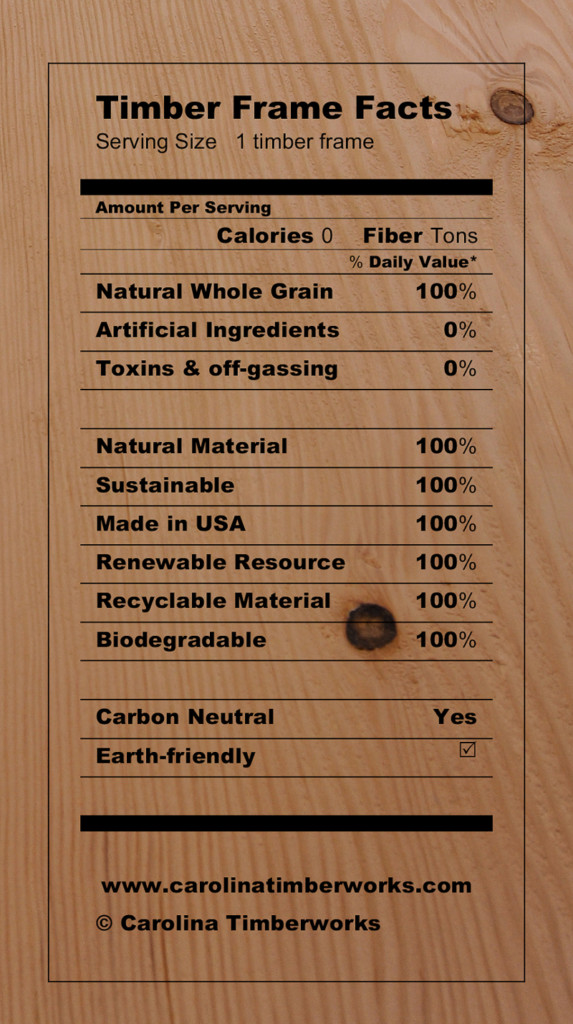What's New
What's new, general information and frequently asked questions about timber frame and post and beam construction, inspired and beautifully built buildings, timber frame home design advice, what woods to use, and best practices.
Check out our timber frame videos for a unique glimpse into our projects and methods.
What is the Best Wood for Timber Framing Projects?
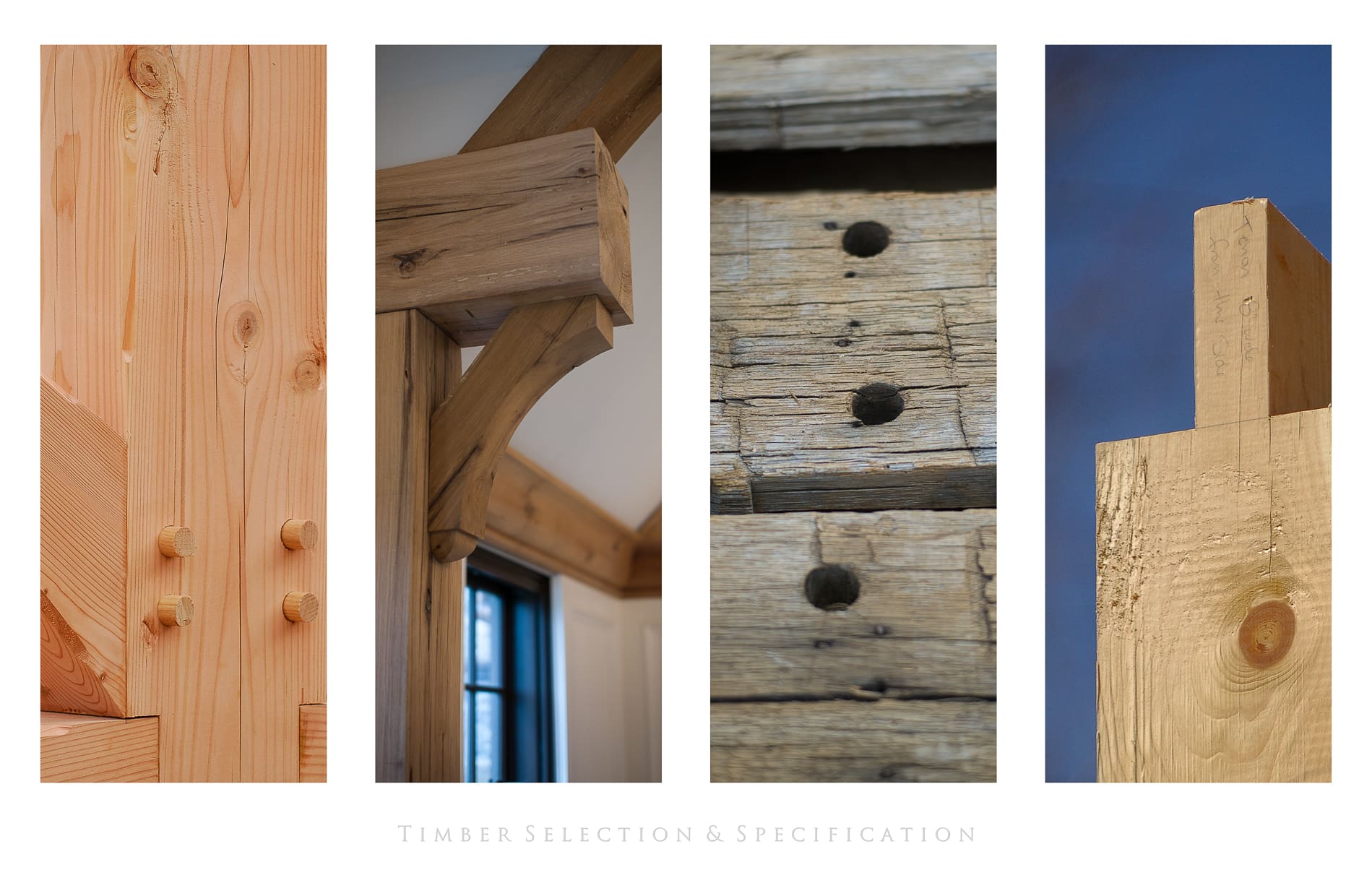
We’re often asked, “What is the best wood for timber framing?” Although it’s estimated that 60% of timber frames in North America are built from Douglas fir, there are other timber frame wood species that may work as well, or better, for your building project.
So, here in one place, is exactly how to select a timber species from the most common woods used in timber framing. Perhaps as important, you’ll learn how to specify the other important wood characteristics for a timber frame — things like timber grade, moisture content, heart content, and surface texture.
What Type of Wood is Used for Timber Framing?
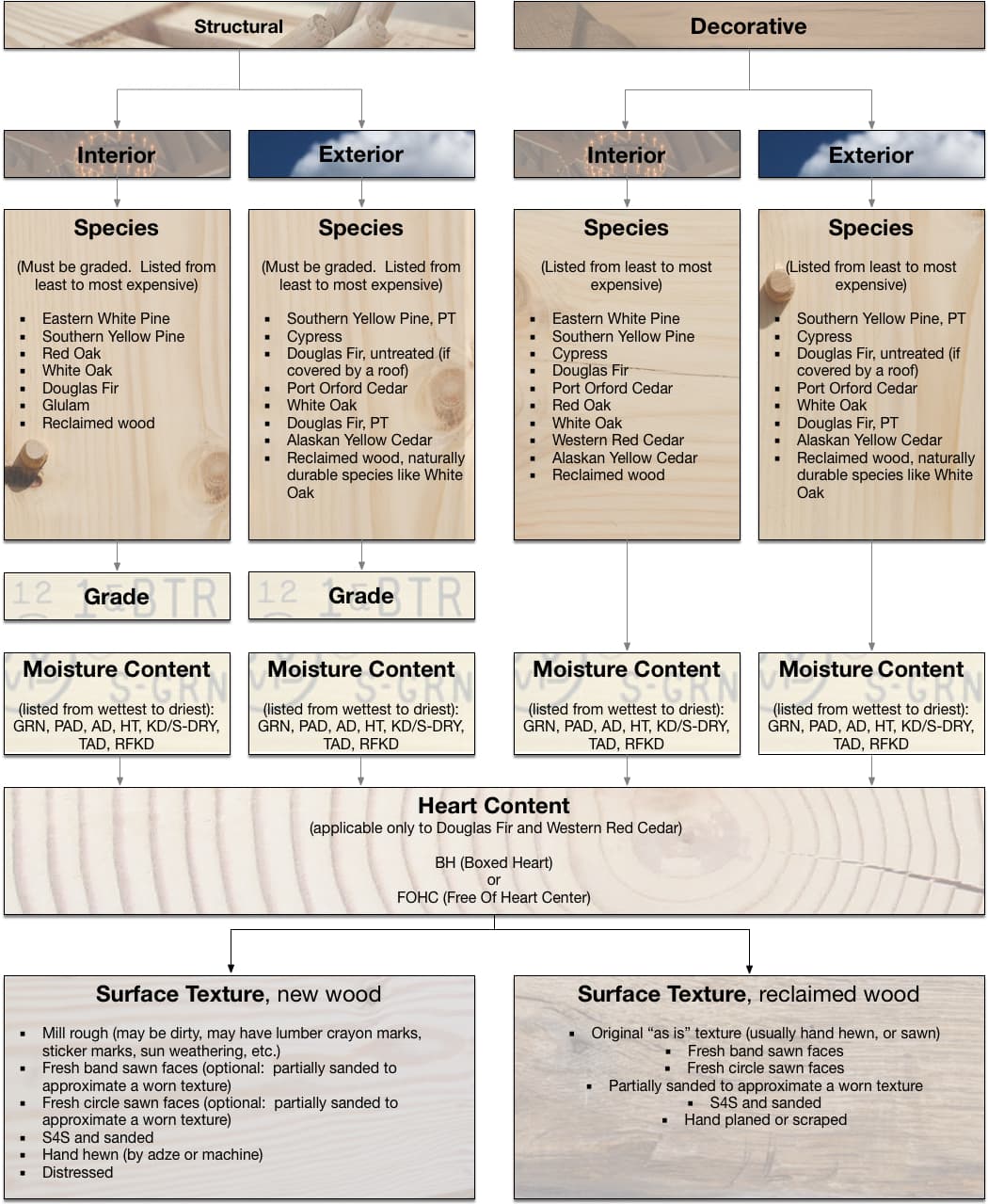
Common Timber Frame Abbreviations
- AD: air-dried
- BH: boxed heart
- FOHC: Free of Heart Center
- Glulam: glued laminated timber
- GRN: green (freshly cut, wet)
- HT: heat-treated (reclaimed wood is sometimes heat-treated to kill bugs)
- KD: kiln-dried (when timber is dried in a conventional kiln, only the outer inch or so is dried)
- PAD: partly air-dried
- PT: pressure-treated (with chemicals to resist decay)
- RFKD: radio frequency kiln dried (dry to the core, but only applicable to Douglas fir
- S4S: surfaced four sides
- S-Dry: surface dry
- TAD: thoroughly air-dried
Confused by timber framing jargon? Our Timber Frame Glossary is a handy resource to make sense of it all.
Characteristics of Common Timber Frame Wood Species
For each of the common timber frame materials used in the construction below, we’ve noted the characteristics, decay resistance, and the relative cost ($ less costly, $$ average, $$$ more costly). Some of the information below is adapted from the USDA Forest Service’s Forest Products Laboratory book: Wood Handbook–Wood as an Engineering Material.
Best Wood for Post and Beam Construction and Timber Framing
The ideal types of wood for timber framing include bald cypress, Port Orford cedar, western red cedar, and eastern white pine. Bald cypress is a popular choice for wetter climates due to its moderate resistance to decay. Port Orford cedar offers a straight grain, a distinctive scent, and high decay resistance, making it a favorite for specialized architecture. Western red cedar is lauded for its very low shrinkage and natural fungicidal properties, increasing durability. Eastern white pine develops a beautiful patina over time, balancing quality with affordability.
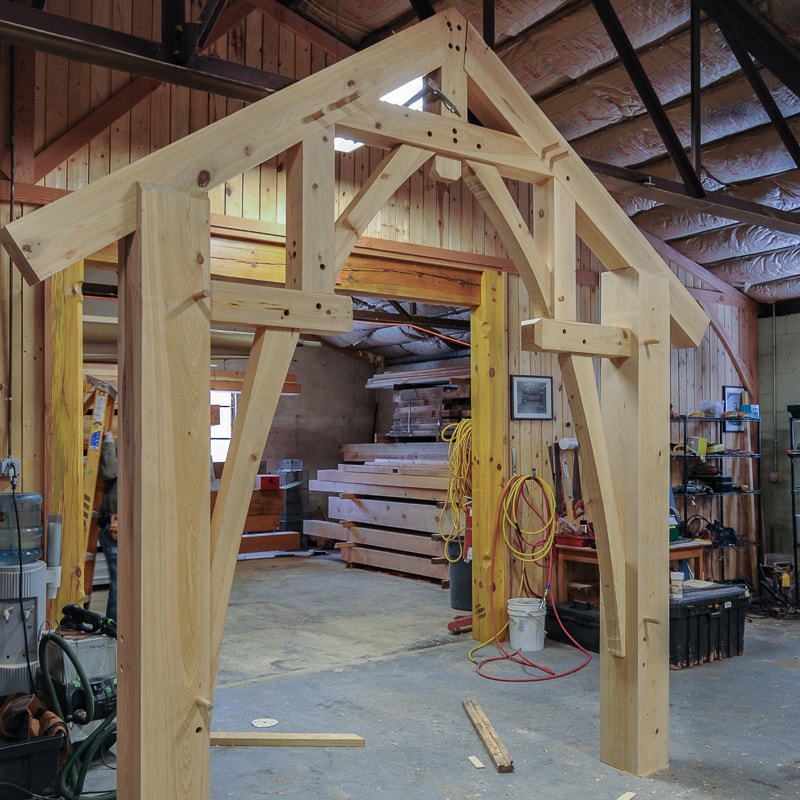
Bald Cypress (Taxodium distichum)
Also known as southern cypress, tidewater red cypress, yellow cypress (inland), and white cypress. Southern US softwood; moderately heavy, moderately strong, and moderately hard. Old-growth is resistant or very resistant to decay, but no longer readily available. Second growth is moderately resistant to decay. Sapwood is narrow and white-colored. Heartwood color varies from light yellowish to reddish-brown color. Shrinkage is moderately low but somewhat higher than the cedars. Difficult to obtain longer than 20′. $$
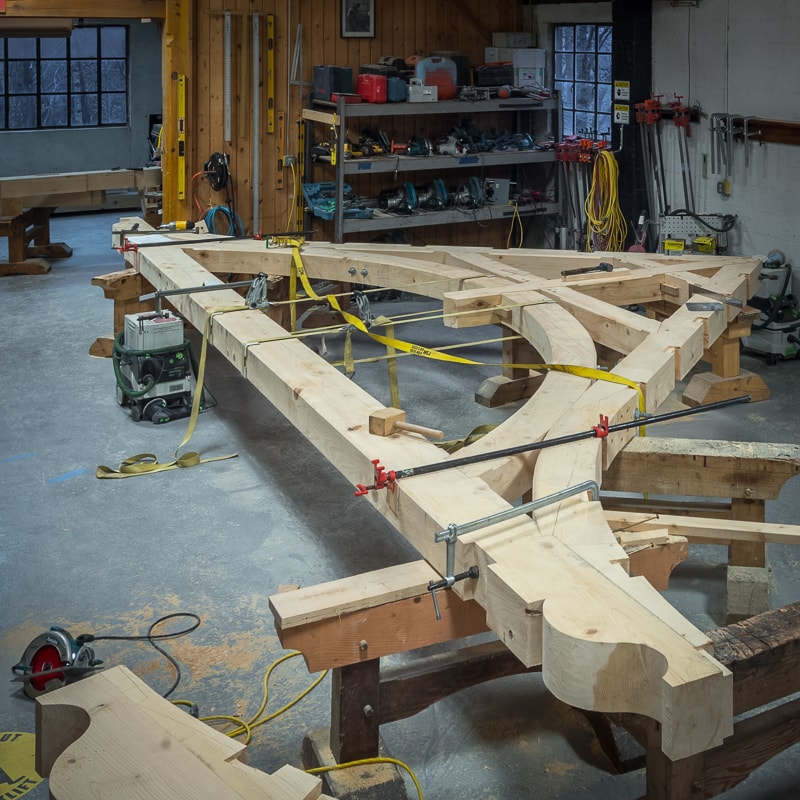
Port Orford Cedar (Chamaecyparis lawsoniana)
Straight-grained, fragrant, and durable. A softwood that grows along the Pacific Coast from Coos Bay, Oregon, southward to California in a narrow band less than 40 miles wide. Fine texture, generally straight-grained, with a pleasant spicy odor (it reminds us of ginger). Moderately lightweight, stiff, moderately strong, and hard. The heartwood is highly resistant to decay. Moderate shrinkage with little tendency to warp. Prized by Japanese temple builders as it resembles Japan’s sacred and rare, Hinoki Cedar. $$
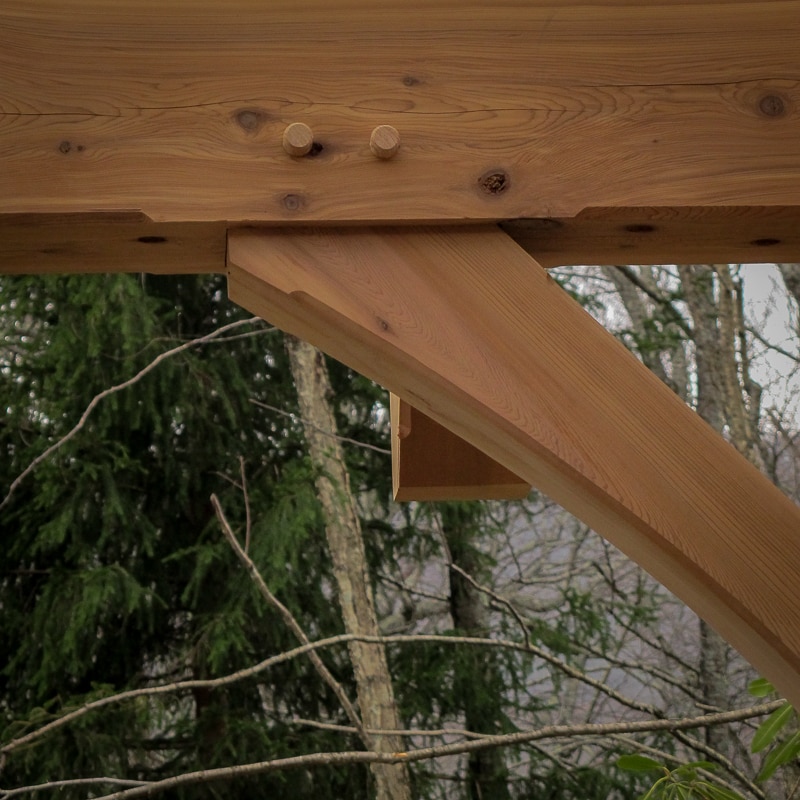
Western Red Cedar (Thujaplicata)
Straight grained, low shrinkage, durable. A softwood that grows in the Pacific Northwest and along the Pacific Coast to Alaska. The heartwood is reddish or pinkish brown to dull brown, and the sapwood is nearly white. Narrow, and usually less than 1″ wide. Very low shrinkage, lightweight, moderately soft, low in strength. The heartwood is very resistant to decay because the chemical substance Thujaplicin, found in mature western red cedar trees, is a natural fungicide. $$$
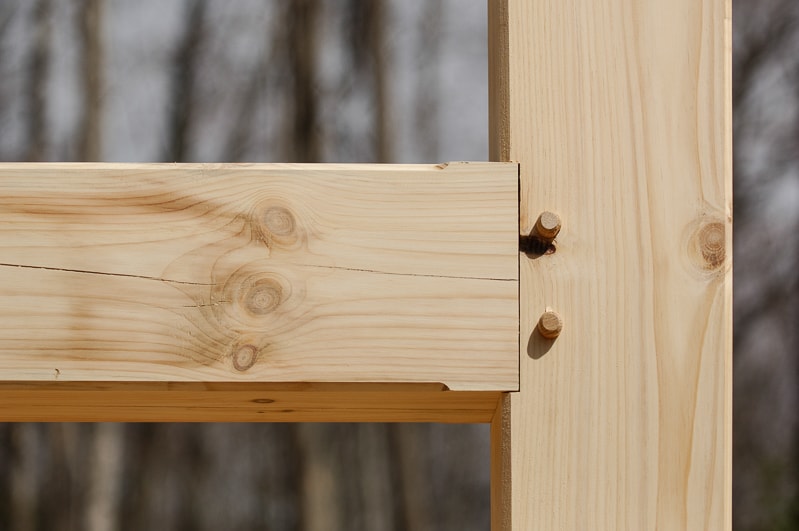
Eastern White Pine (Pinus strobus)
The “moderate” timber: moderately soft, moderately low in strength, moderately durable, and moderate shrinkage. A softwood that grows from Maine to northern Georgia and in the Great Lake States. Challenging to obtain graded for structural timber framing. Creamy white or pale straw to light reddish-brown. Darkens with time to a light caramel color, then after many years to a deep rich golden tan. Stains well. $
Learn More: Our Timber Frame Glossary
Timber Traditions: Our Industry Customs
Timber framing has been around, in some form or another, for over 2,000 years. So it stands to reason, some interesting timber framing traditions and customs have sprung up in connection with timber frame construction. We thought we’d share some of the more interesting ones…
Common Timber Frame Traditions
Topping Out Ceremony and the Wetting Bush
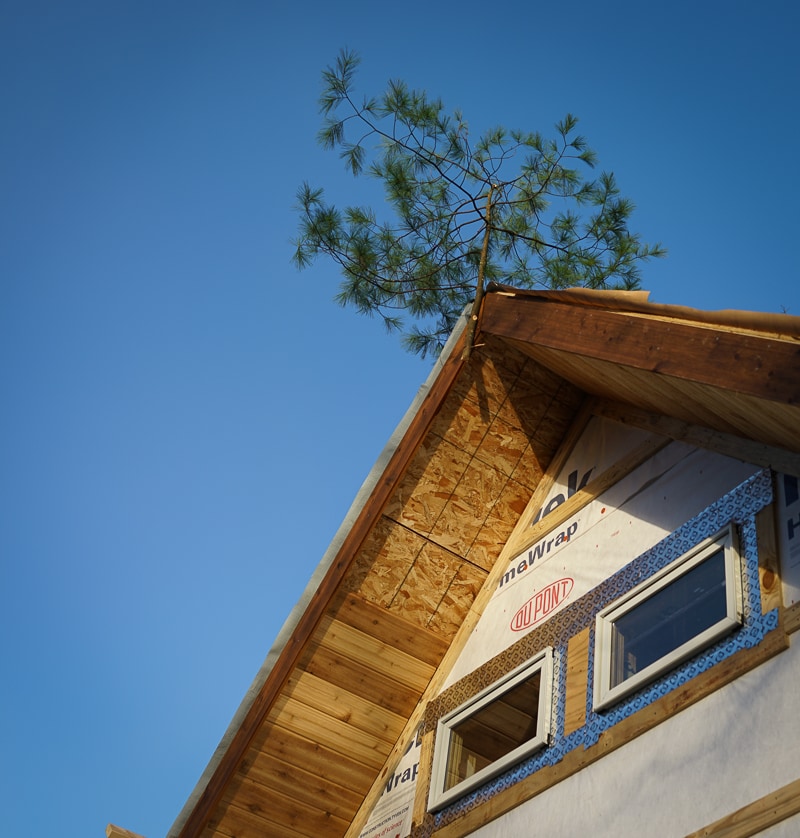
One of the more well-known timber traditions involves nailing a bough or small evergreen tree to the highest point of the timber frame. According to Fine Homebuilding Magazine,
The ritual serves two purposes. One pays homage to all the trees that went into the construction of the house, and to the many hands that built it. The other symbolizes the establishment of the house’s roots, which will nourish a long and prosperous life. The young tree is called a “wetting bush”, likely derived from the German tradition of watering it as a sign of the home’s first nourishment.
So, who gets to set the wetting bush? The youngest carpenter present.
The Barn Raising
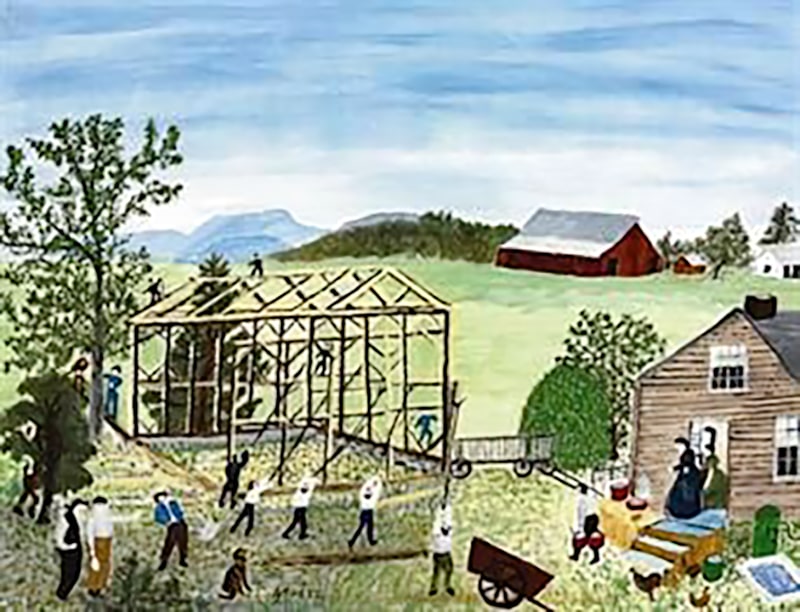
Of course, this might refer to a home, an outbuilding, or even a post and beam shed, but Barn Raising evokes an image familiar to most of us–a community coming together to accomplish something big.
In the “olden days” the individual timbers for a house or barn would be cut and fitted by just a few men or a family. When all the individual walls were ready, the whole community would come together to raise the walls into position and set the rafters and ridge beam in place. This would be done using gin poles, ropes and pulleys, and of course, strong men. Although hard physical labor was required, “many hands make light work”, and the day ended with a celebration and party. The wives and children participated and a feast was held. There’s a real nostalgia in the thought of honest labor and participation in a feat that none of the individuals could have accomplished alone.
The Group Photo
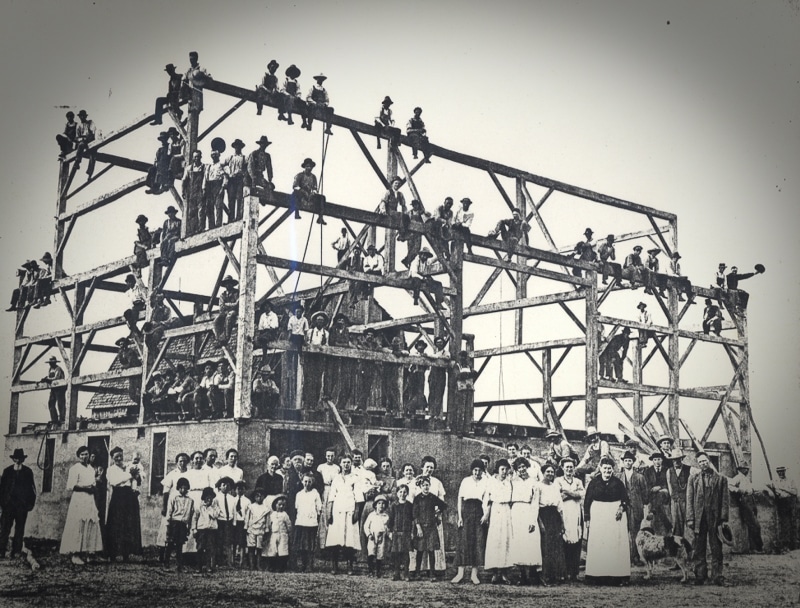
This doesn’t happen when the sheetrock goes up…but once the last timber is raised and pegged, the moment is documented with a photograph. Why? Perhaps because timber framers often feel that the timber frame will never be more beautiful than at that moment (before it is covered by walls and a roof), perhaps because all present sense that this structure will outlast every one in the picture.
Feeding the Framers
Whether it’s a tradition, or simply good manners, timber framers always appreciate a hearty meal! So they perpetuate the superstition that feeding the crew will bring the building (and Owners) good luck…
Slaking the Framers’ Thirst
A French tradition, courtesy of Charpentiers Sans Frontières (Carpenters Without Borders), is to give the lady of the house the honor of pounding in the last peg. She is expected to owe the crew one drink for every blow of the mallet required to drive the peg home.
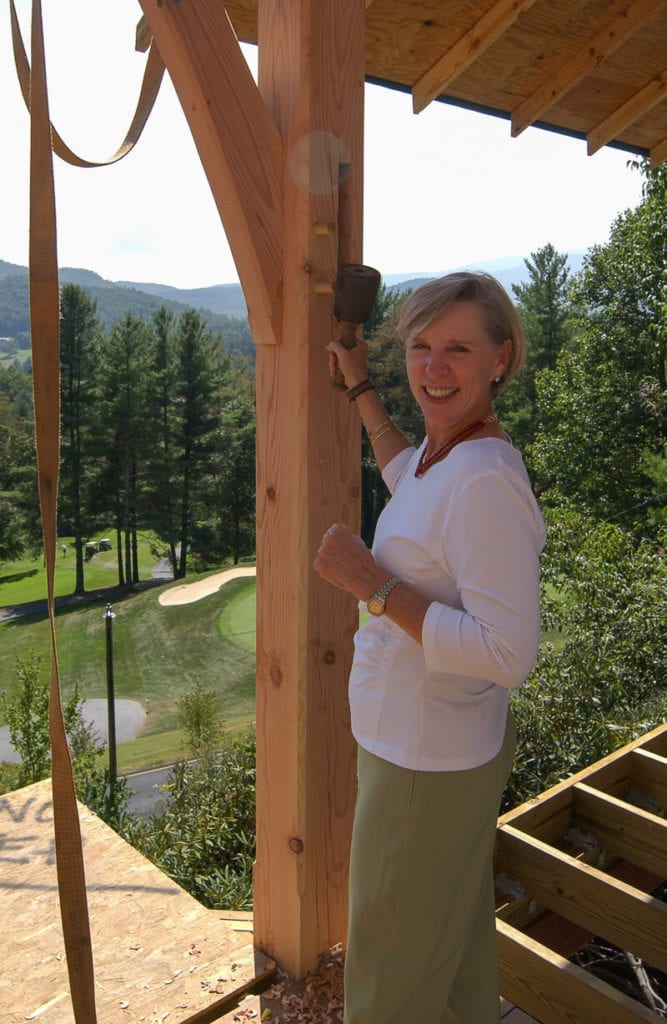
Using a Coin to Date the Building
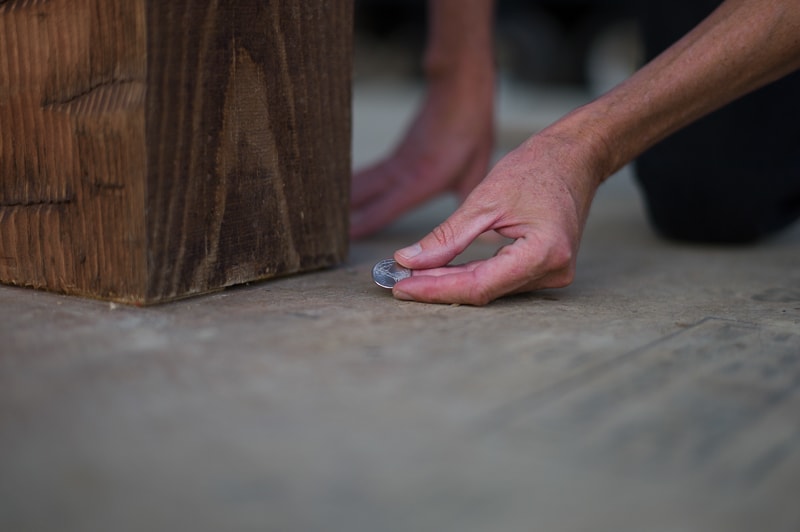
Think of this as a very abbreviated time capsule! A coin minted the same year as the structure is built is placed under a post, where it (presumably) will not be found until the building is dismantled (and hopefully the timber frame reclaimed).
Carving the Date
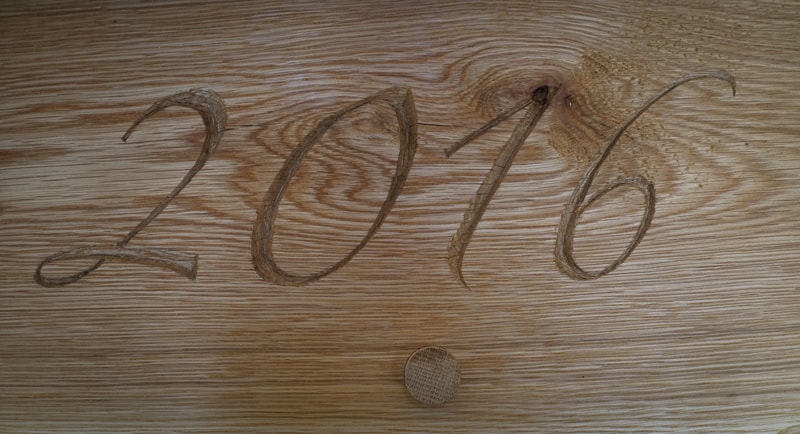
The date of completion is carved into the frame. This may be done in a visible and conspicuous place, such as over a doorway, but it might also be done in a less obvious spot. For example, some timber frame companies carve the date in the location on the frame closest to where the home shop is located. In our case, the date would be carved on the side of the building closest to West Jefferson, North Carolina.
Signing the Frame
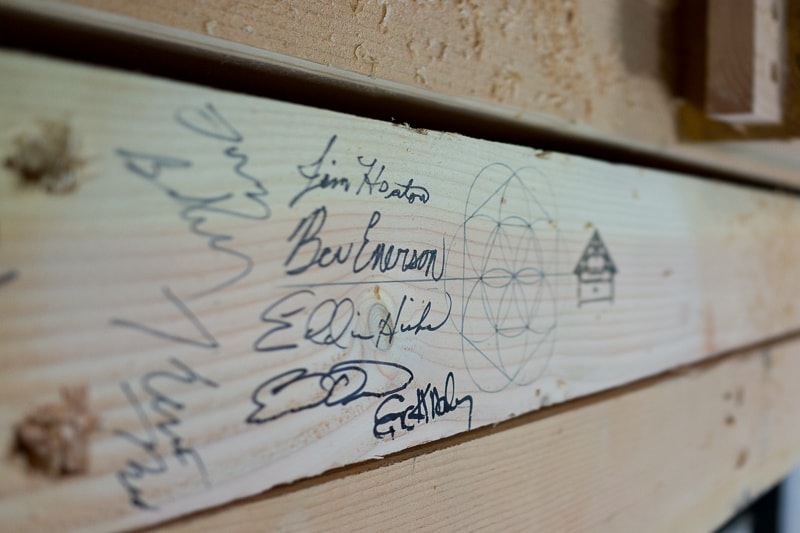
All the timber frame craftsmen (and craftswomen) who worked on the frame sign one of the timbers in a hidden place where it may lie undiscovered for a century or more.
Topping Out in Space

One of our clients worked for NASA and sent a photograph of Mission Specialist Joe Tanner topping out the International Space Station. The evergreen tree represents the highest point (top of the P-6 integrated truss structure) of the ISS.
Learn More: Our Timber Frame Glossary
Why Do Timbers Split and Crack?
Eric Morley on why timbers split and crack, how long it takes timber to dry, where to get dry timbers, and why gunshots in the night are nothing to be afraid of when you understand wood checking and splitting.
Wood checking and splitting, a natural phenomenon in timber, occurs as the wood dries and loses moisture. This process leads to split wood and cracked wood, known as “checks.” While they do alter the appearance of the timber, checks also add unique character without affecting the wood’s structural integrity.
What Causes Wood to Crack?
Drying Does!
Splits and cracks (known as wood checks in the industry) occur when wood shrinks as it dries. Wood shrinks roughly twice as much along with the growth rings (radially) as it does across the rings (tangentially). It is this uneven shrinkage that causes checks to develop.
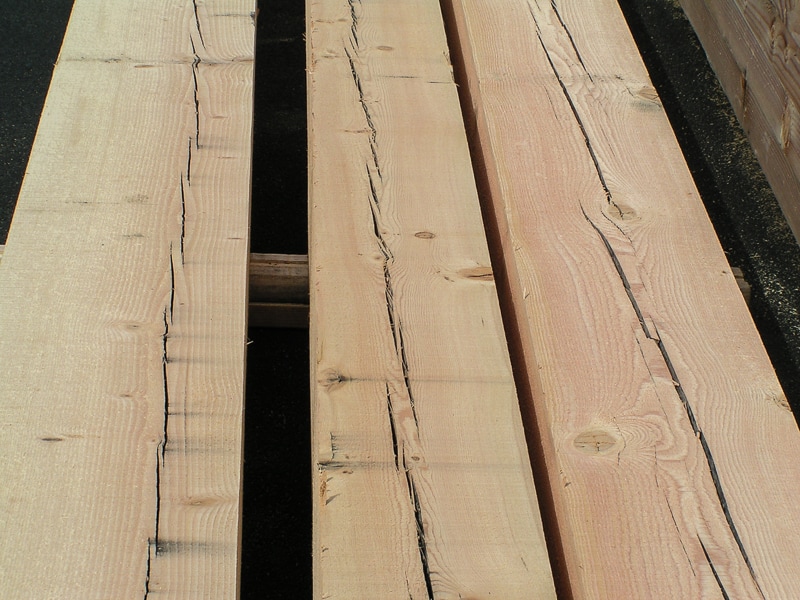
Is Wood Checking Bad?
Here at Carolina Timberworks, we think of them as wrinkles in a cotton shirt. It proves the timber is real. Checks are what make a solid timber look different from a boxed beam. Look at the reclaimed timber below. It is impossible to predict where a check will appear in timber. It is the check that gives this reclaimed white oak timber so much of its character and a big part of what makes it completely unique and different from any other beam in the world.
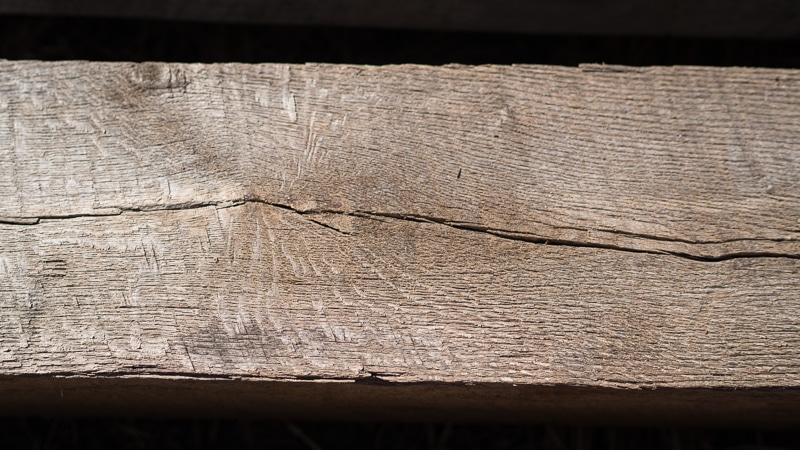
Ever Heard the Song of the Wood?
Have you ever taken a hot loaf of artisan bread out of the oven, and put your ear to it? If you do, you’ll hear the song of the bread–pops and crackles as the crust shrinks, cracks, and dries.
Walk into a timber framer’s shop one winter evening when everyone has gone home for the day. Throw another log into the woodstove, and listen carefully. If there are green (wet) timbers arrayed on sawhorses, within a few minutes, you’re likely to hear the song of the wood – a symphony of pops and cracks as wood checking occurs.
If one night, asleep in your new home, you’re awoken by a loud crack a little like a gunshot. Don’t worry. Roll over and go back to sleep. It’s just your timbers singing to you. That’s wood checking in action.
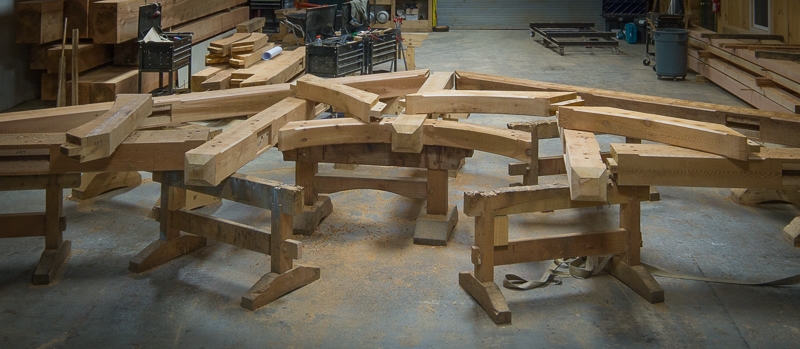
Why Does Wood Shrink?
It sometimes surprises people to learn that roughly half of a living tree’s weight is water. Let’s consider a 24’ long Douglas Fir log that measures 34” diameter at the large end and 14” at the small end as an example. This hypothetical green (wet) log would contain a little over 1 ton of water or about five 55-gallon drums of water.
Sometimes when we drive a chisel into green (wet) timber, water spurts out of the wood. Wood is hygroscopic – meaning it’s like a sponge in that it can absorb, hold and release water. When freshly cut, approximately half of a tree’s weight is water. The photograph below shows water in a freshly cut cypress timber–and how the timber is drying from the outside in.
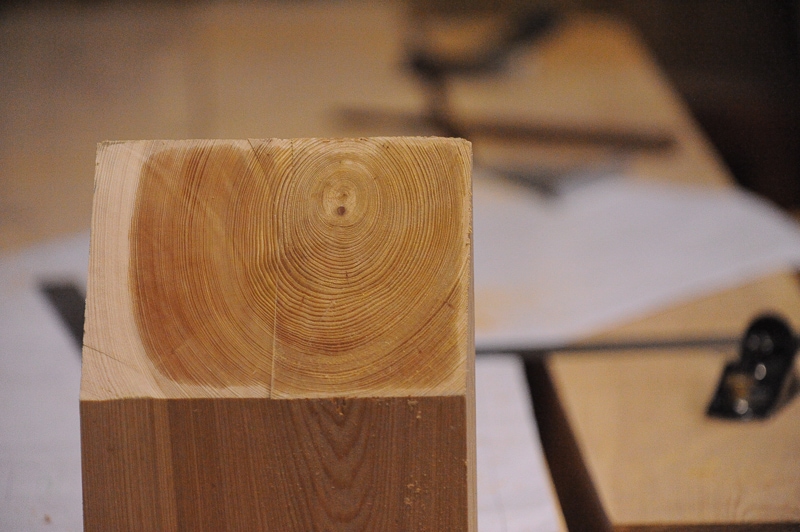
How Long Does It Take a Timber to Dry?
It’s not exactly a fast process. It depends on the humidity of the environment in which the timber is located, but a rule of thumb is that timber air dries about one inch per year. Thus a 12” x 12” timber would take about six years to dry to the center.
How Dry Will the Timber Become?
A timber will eventually air dry to the Equilibrium Moisture Content (EMC) of its environment. The EMC is the point at which wood is neither losing nor absorbing water. A timber’s moisture content is determined by the atmospheric humidity of the timber’s environment.
That environment varies, of course. Is the timber located inside, or outside? What part of the country is it located in? What time of year is it? For example, in the dry mountain air of Denver, the outdoor EMC of wood exposed to the outdoor atmosphere in July is 9.4%, while New Orleans is 15.3% (Forest Products Laboratory: Equilibrium Moisture Content of Wood in Outdoor Locations in the United States and Worldwide, August 1988).
How Wet (or Dry) Are My Timbers?
Since we can’t see the water in the wood, moisture meters are used to measure moisture content. Inexpensive moisture meters measure the surface moisture content which works ok for 3/4” boards, but not 8” thick timbers. Professional moisture meters use electromagnetic scanning to read the moisture in the wood, not on the surface of the beam.

What is the Average Moisture Content in the U.S.?
The majority of the U.S. has an 8% average moisture content, the Southeast and California coastal areas have an 11% average moisture content, and the Southwest desert areas are closer to 6%.
Most Timber Frames Are Built From Green (Wet) Wood
It is impractical (it takes years) to air dry timber, and timber frame customers are nothing if not impatient, so for the last two thousand years, people have been building timber frames from green (wet) timber. Yes, green timber will shrink, check, and sometimes twist as it dries, but timber framers and engineers understand and account for the movement. Checks begin on the exterior surface of the timber and almost always stop at the heart (center) of the timber, and are almost never a structural concern.
By the way, if a crack were to develop all the way through a timber (splitting timber it into two separate pieces), it would be called a split and might be cause for concern.
Learn more about timber framing all the ways timber can be used here.
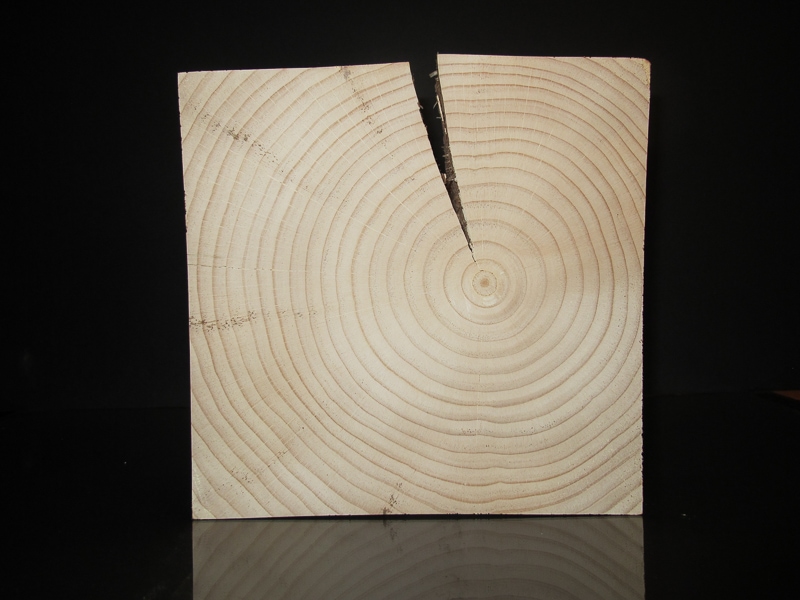
How Much Does Green (Wet) Timber Shrink as It Dries?
Shrinkage depends on the species, but more than you may think!
Since many timber frames are built from Douglas Fir, let’s start by looking at a 12×12 Douglas Fir (Coastal) timber. This particular green (wet) Douglas Fir timber, dried to a final moisture content of 8%, would be expected to shrink a little less than 9/16” on each face from 12” x 12” to a final size of 11-7/16” x 11-7/16”.
Western Red Cedar shrinks less: The same size timber in Western Red Cedar timber would shrink a bit less about 5/16” to 11-11/16” x 11-11/16”. Finally, how about a species with a high shrinkage rate, like White Oak? It would be expected to shrink a bit less than 3/4” to slightly larger than 11-1/4” x 11-1/4”.
6 Ways to Minimize Problems with a Green (Wet) Wood in a Timber Frame:
- Specify Free-Of-Heart-Center (when available) instead of the lower Boxed Heart grade.
- Apply a wax-based end sealer to the end grain to slow the drying process. We use Anchorseal, available at https://uccoatings.com/products/anchorseal/.
- Utilize housed joinery wherever possible.
- Drawbore pegged joints.
- The slower the wood cracking when drying, and the more gradual the process, the better (i.e., the worst thing you can do is enclose the timber frame and immediately turn on the heat or air conditioning full blast.)
- Do not apply a film-forming finish (i.e., polyurethane) to green (unseasoned) wood.
- Sawing checking kerfs on an unseen timber face is a good practice and can help mitigate the visual checking.
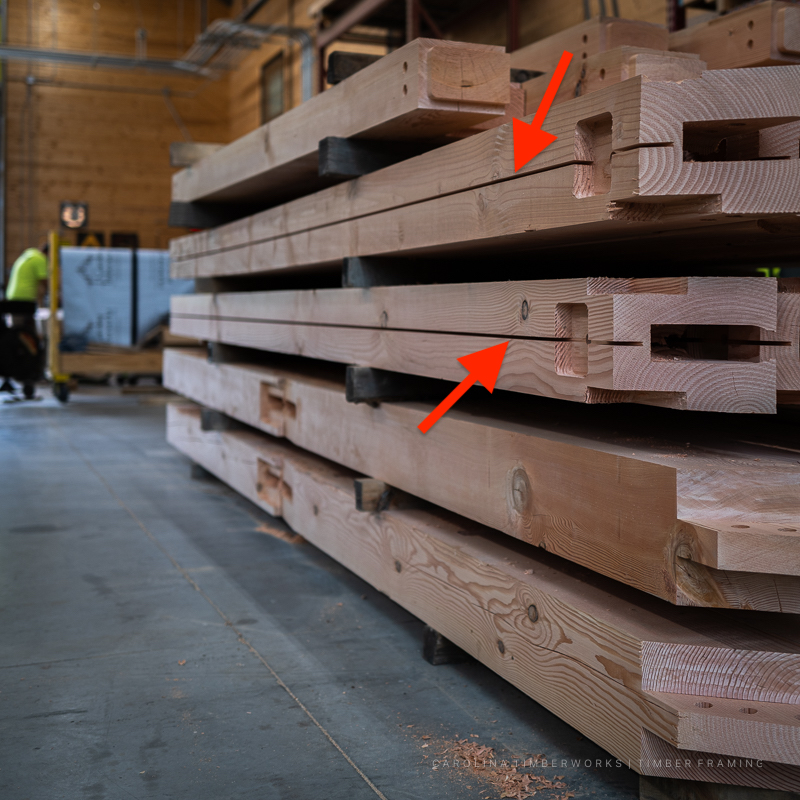
I Don’t Want Wood Checking or Cracks in My Timbers. What Are My Options?
Don’t build with solid timber. Instead, ask us to price glulam beams for the timber frame, or to fabricate box beams from kiln-dried new or well-dried reclaimed lumber.
If you’re ok with some checks, but would prefer to avoid some of the characteristics of green lumber, consider purchasing your timber like you do your high-quality organic cotton t-shirts–pre-shrunk. There are two ways to buy dry beams: new timber that’s been dried in a kiln, or reclaimed wood that’s dried slowly and naturally for 50 or 100 years during its previous life as a timber frame barn or warehouse.
Where to Buy Kiln Dried Timbers?
We offer two types of kiln-dried timber: Conventionally kiln-dried (KD), and Radio Frequency Kiln Dried (RFKD). Conventional kiln drying dries about the outer 1” or so leaving most of the timber wet. The other method, RFKD, is similar to a giant microwave and dries timber to the core.
What you need to know about RFKD timber is that it currently works only on Douglas Fir, it is dry to the core, and it is more expensive. It is, however, not as dry as conventionally kiln-dried hardwood flooring or lumber (6-8% moisture content). For example the driest grade of RFKD timber measures 15% or less moisture content 3” in from the surface of the timber.
What About Using Reclaimed Wood in Timber Frame Construction?
Reclaimed wood beams that have naturally air-dried for 50-100 years during their previous life as a barn, factory, or warehouse are often completely dry to the core and the driest timbers available anywhere. It’s not easy to hand-scribe and connects irregular, twisted, and non-square reclaimed beams so the finished timber frame appears to have always been one frame.
We think a timber frame built from reclaimed wood is everything that today’s sleek, mass-produced, technology-saturated culture isn’t. It celebrates the cracks and character and dirt and all the other marks that time, weather, and use leave behind.
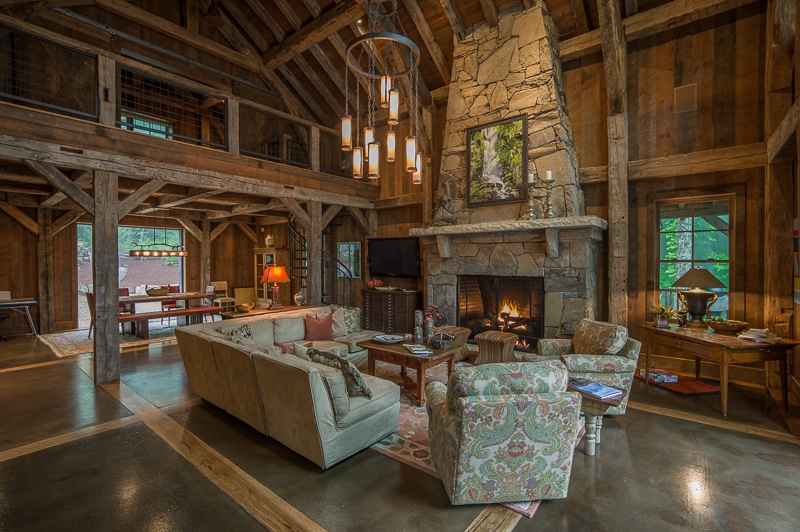
Interested in learning more about timber framing? Check out our timber frame blog.
The Benefits of Timber Framing
When you design a new home or modify your existing space, deciding on a building method is one of the first—and most important—choices you’ll have to make. If you’d rather avoid the standardized look of conventional construction, then the handcrafted aesthetic, the gorgeous exposed beams, and the open floor plans synonymous with timber framing may have caught your eye.
But is this method of building really the right choice for your home or family? What are the advantages of timber framing—and are there downsides you should know about?
At Carolina Timberworks, our team has collectively had more than 90 years to ponder these questions. Here’s what we think, based on our first-hand experience with building and customizing timber frame homes.
What Are the Benefits of Timber Framing?
We can think of quite a few:
It’s an Art
While watching Fine Homebuilding’s video of architect Caleb Johnson of Biddeford, Maine, discuss the winner of the 2015 Best New Home award, we were struck by his profound insights into timber frame benefits. His words beautifully capture why we’re drawn to and love timber framing: “Built poetry.“
“The materials go together in a fashion that you can tell he (architect Louis Kahn) cared deeply about the nature of those materials and the way they came together on a level that’s art–not just construction.“ It’s true: we’ve found that timber framing is much more than a building method. It’s an art.
It Gets Better With Age
As Caleb Johnson says, “If we use natural materials, as time goes on, these natural materials take on a character and patina that enhances the building. Whereas when you use manufactured materials, those materials will look best the day you put them in, and they will deteriorate from there, and there’s really nothing you can do to bring them back.“
Building a timber frame home requires heavy timber and wood joinery, which is about as natural as it gets. What does that mean for your family? You can expect your timber frame home’s aesthetic to continue to evolve and develop a character of its own over time. In other words, it gets better with age.
It’s Sustainable
From the new wood to the concrete and steel, stick-built homes are often the opposite of sustainable. Conventional construction generally uses highly embodied resources that produce extensive carbon emissions and younger trees that never get to realize their potential as a carbon sink.
In contrast, timber framing tends to be much more sustainable. What do we mean when we say timber framing is sustainable? This short comic says it all:
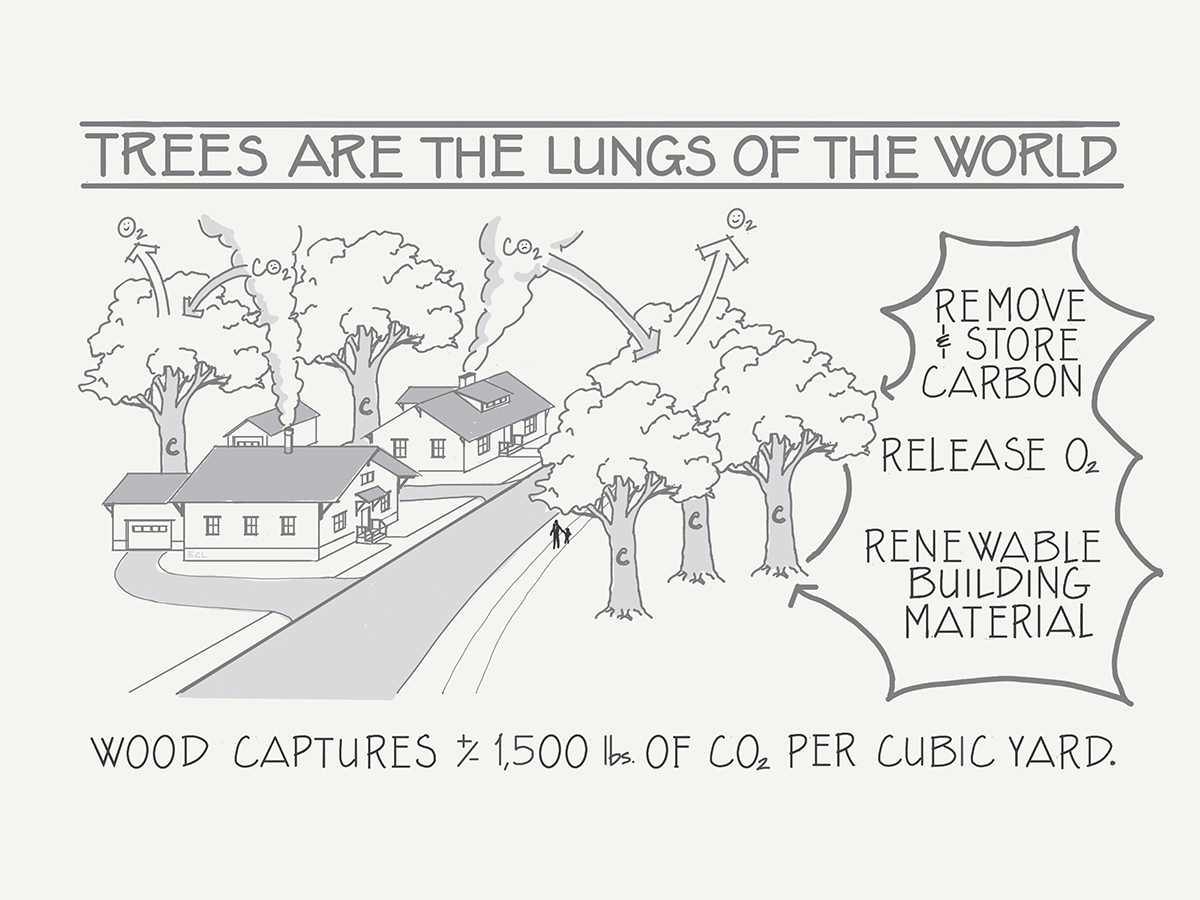
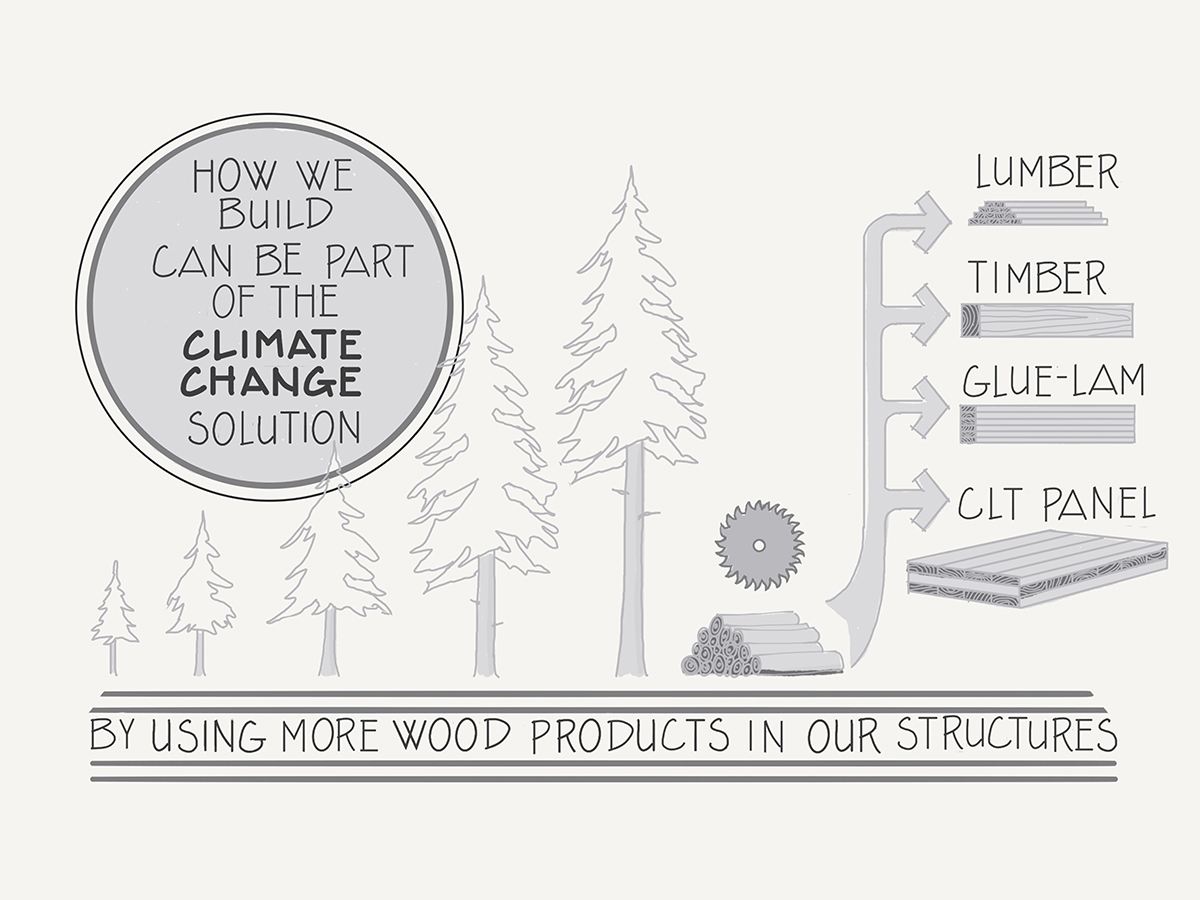
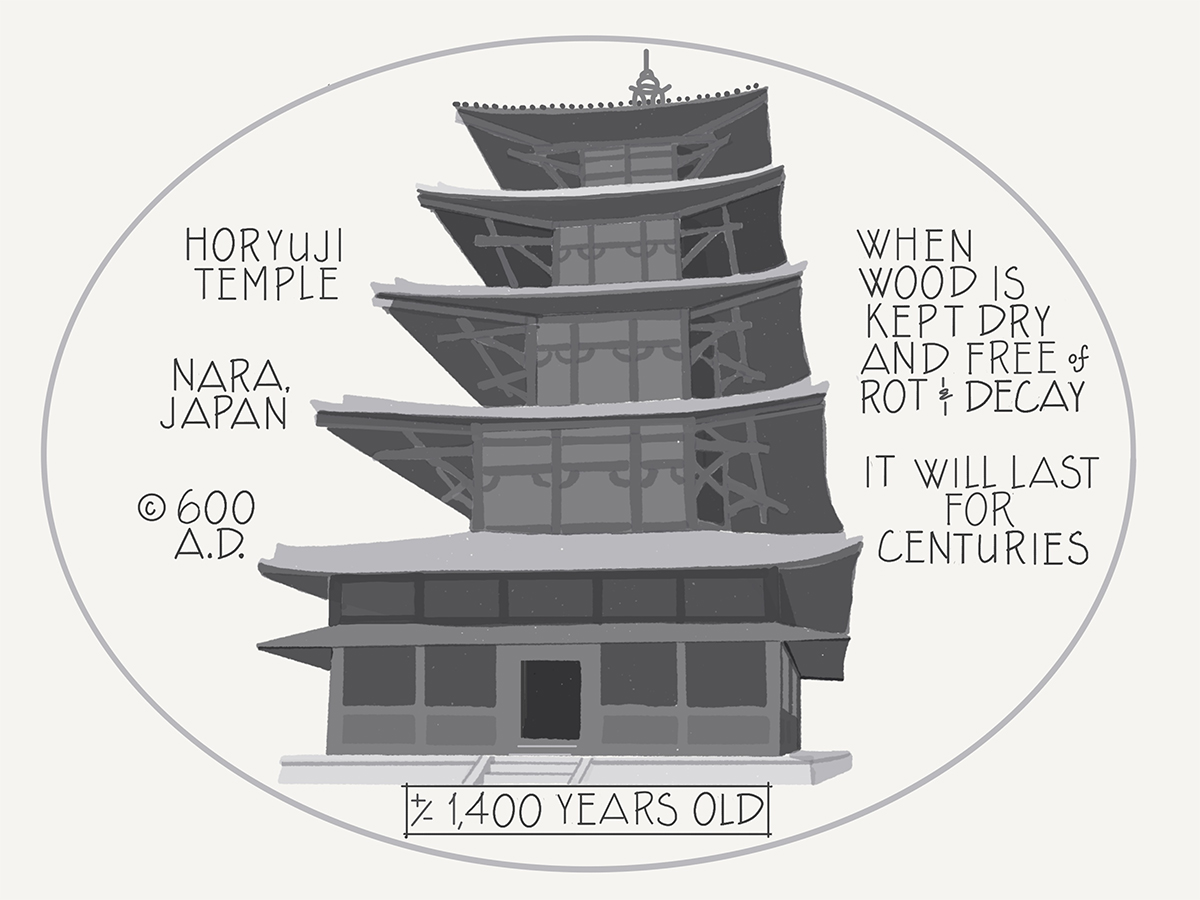
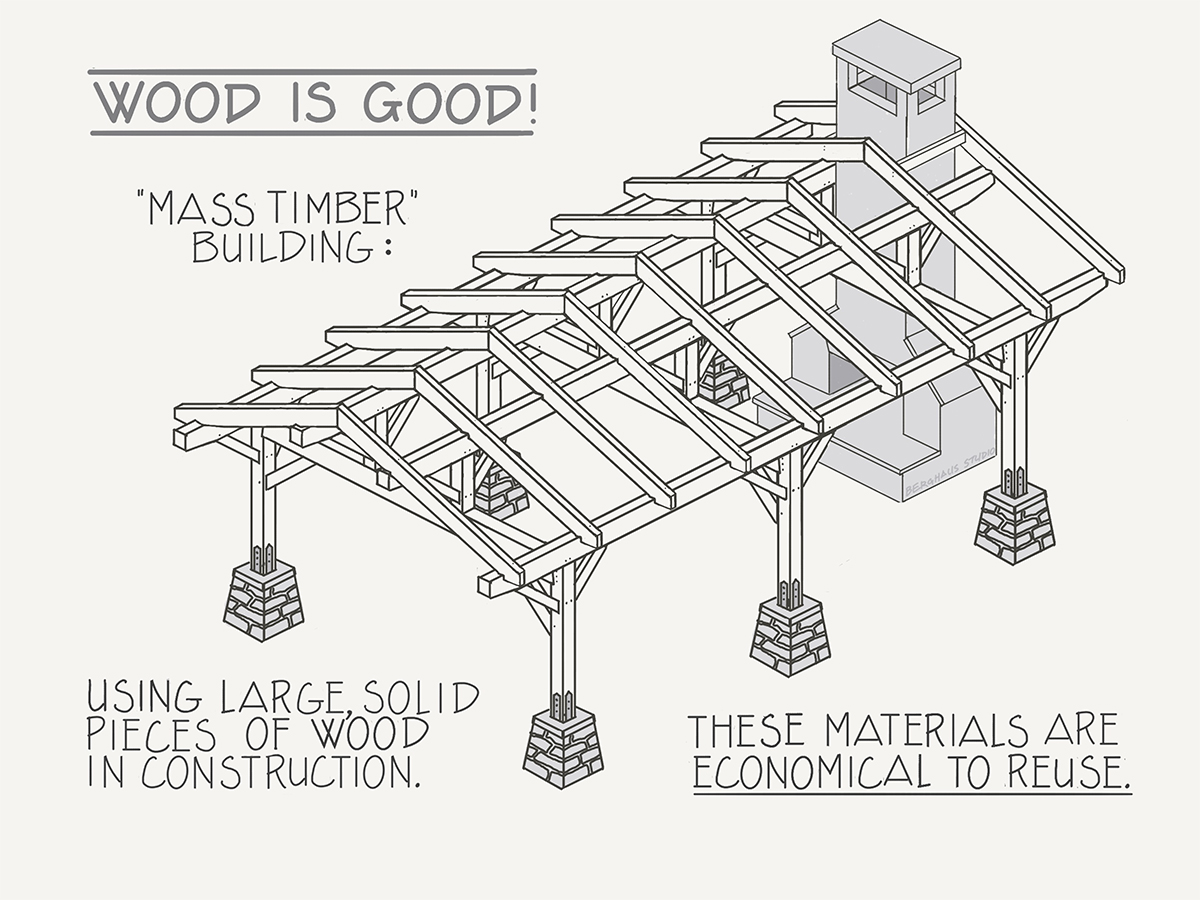
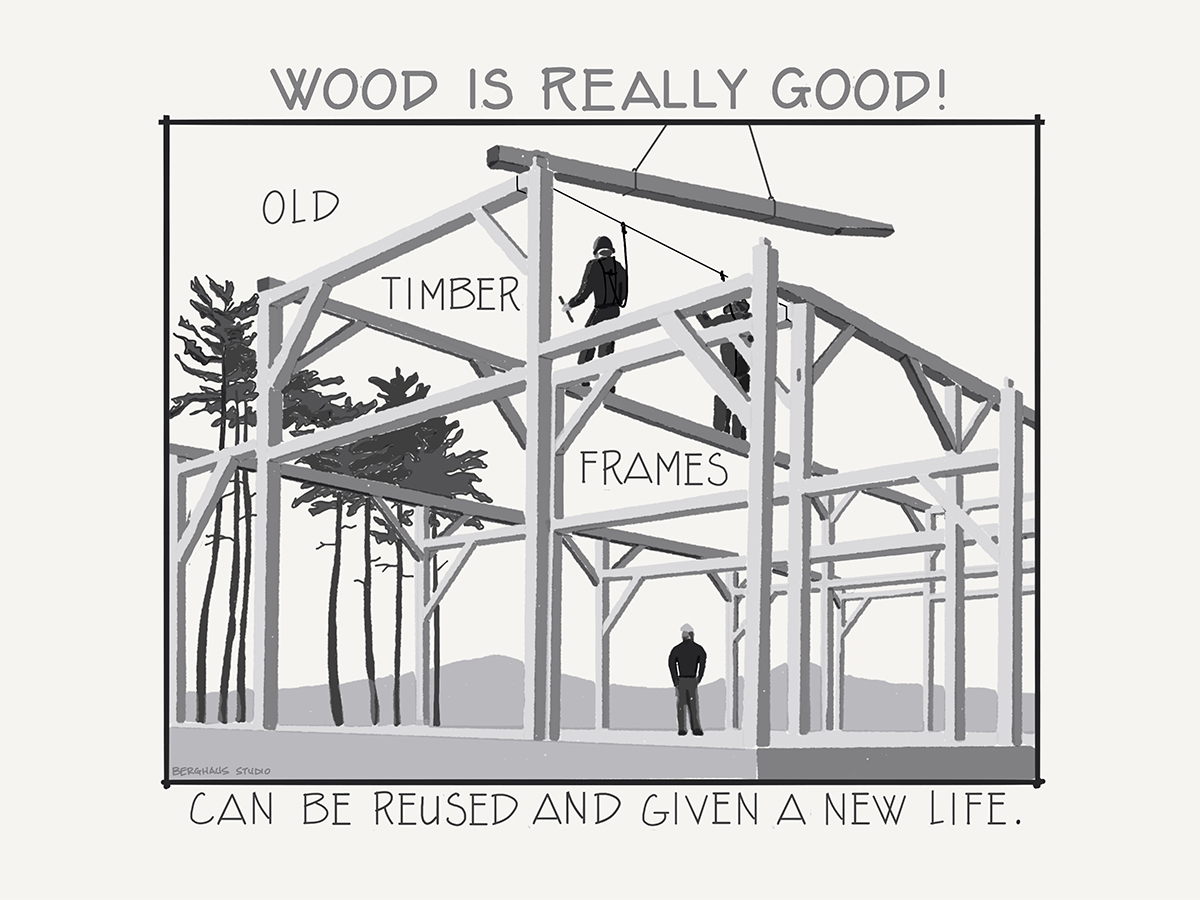
It’s an Experience
A timber frame structure doesn’t typically require load-bearing walls. That means a timber frame home can often support (literally!) open floor plans that go beyond what conventional construction could create.
But that’s not all. As Caleb Johnson says, “I feel that the structure of a house can be the most expressive part of the architecture and I feel that when that structure is exposed, it’s most powerful when it’s authentic–like it’s actually bearing the load of gravity pulling the house down and the winds trying to push the house over.“ In other words, let’s just say living in a timber frame home is quite an experience.
Are There Disadvantages to Timber Framing?
Any timber frame company that tells you there are no downsides isn’t telling you the whole story. Most importantly, you should know that timber framing tends to cost more than conventional construction for a variety of reasons, including the engineering, the highly skilled labor, and the high-quality wood. Even if you opt for a timber frame home kit, you can expect it to be more expensive than a stick-built house—especially if you intend to modify the plans dramatically.
Can you cut the costs? Sure, there are a few ways to make timber framing less expensive. From careful planning to rethinking room size to repurposing space creatively, we have several suggestions for how to fit timber framing into your budget.
Need help understanding timber framing terms? Browse our Timber Frame Glossary for easy-to-understand explanations of the basics.
Should You Build a Timber Frame Home?
It may come as no surprise that at Carolina Timberworks, we think there’s nothing better than a timber frame structure. But a timber frame house certainly isn’t the right choice for everyone. So how can you decide? Take a look at our timber frame portfolio to see our work in action or contact us to talk about your project. We’re nice!
Special thanks to Shannon Richards of Caleb Johnson Architects for permitting us to reproduce Caleb’s words.
Build a Party Barn!
A timber frame barn can be much more than a space for animals or equipment storage. Thanks to their honest aesthetic and open space, these structures are gaining popularity as party barns and entertainment venues.
What Are Timber Frame Party Barns?
A party barn is a timber frame structure that looks like a traditional barn—but can easily transform into a space for gathering or entertaining. As a timber frame structure, it has all the essential elements of this type of construction, including exposed heavy timbers, wood-to-wood joinery, and plenty of open interior space.
What Else Can You Do With a Party Barn?
Timber frame party barns are multipurpose buildings. Here are a few party barn ideas:
- Wedding Venue: No matter the size of your wedding, party barns can set the scene for a grand experience or an intimate affair.
- Family Gatherings: Thanks to their cozy feel, party barns also work well as family gathering spaces for anything from a birthday party to a baby shower to a graduation celebration.
- Yoga Classes: With all that open space, party barns are great for meditative, low-impact movement like yoga.
- Car Barn: It might be a good time to invest in iconic vintage cars and trucks. For a long time the auto industry said that electric cars wouldn’t work, couldn’t achieve the range and performance, and even if they did, nobody would buy them. Although reports of the demise of the internal combustion engine may be exaggerated, increasing global wealth means there’s more money chasing a finite number of classic vehicles. Once you’ve begun acquiring your collection of classics, a heavy-timbered car barn is (we think) the most beautiful way to showcase and protect your collection. Finally, the sound of a high performance engine echoing in the rafters of a heavy-timbered barn is a welcome antidote to today’s digital world (and commutes are a lot more fun).
- Man Cave: Whether you place it on the main floor or on an upper level of a party barn, a man cave can be the ideal spot for watching the game or relaxing with friends.
- Rental Space: Not sure how often you’d use a party barn? You might consider renting it as an event venue so others can enjoy the space too.
How Carolina Timberworks Approaches Party Barns
Whether it’s the cathedral-like atmosphere or the honesty of the structure, barns seem to resonate with people. Case in point:
“Buy it.” I asked Jim Becher to repeat what he’d just told me. Then I had to admit we didn’t have enough money in our checking account to buy the antique timber frame barn in Pennsylvania I’d been telling him about. “You’ll have a check by FedEx tomorrow morning.” He told me he was looking forward to working with us and hung up.
My next call was to the architect (Jim Meyer of Meyer Greesen Paullin Benson) to ask if he thought Mr. Becher was serious. After Jim Meyer assured me I didn’t need to worry about Jim Becher’s word, my third call was to my Mennonite friend in Pennsylvania, who that morning had emailed me photos of a spectacular antique hand-hewn Oak timber frame barn he was reclaiming. I told him we had a client who wanted to purchase the timber frame barn and build a party barn on his farm.
So began our involvement with Jim and Betty Becher’s fast track project to convert their existing cattle barn into a party barn. Betty and Jim’s inspiration to build a party barn came from a visit to Blackberry Farm in Tennessee, and the fast track part of the project came from Betty’s approaching birthday party deadline.
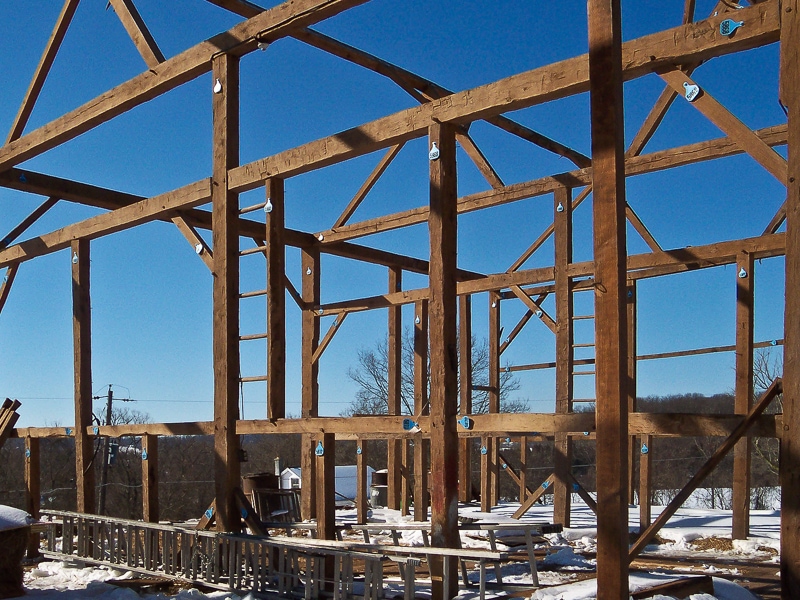
The first thing we needed to do was get the 200-year-old Pennsylvania barn to our timber frame shop. The reason? We needed to know if it contained enough timber in the right sizes and lengths to build what the architect had designed for the space. It turned out that there wasn’t enough long timber in the first centuries-old timber antique barn, so we acquired a second post and beam barn – this one a few miles outside Gettysburg. Here’s what the first barn looked like during dismantling:
To fully appreciate this project and the party barn plans that go with it, it helps to know that it was completed from start to finish in four and a half months. Here are the before pictures:
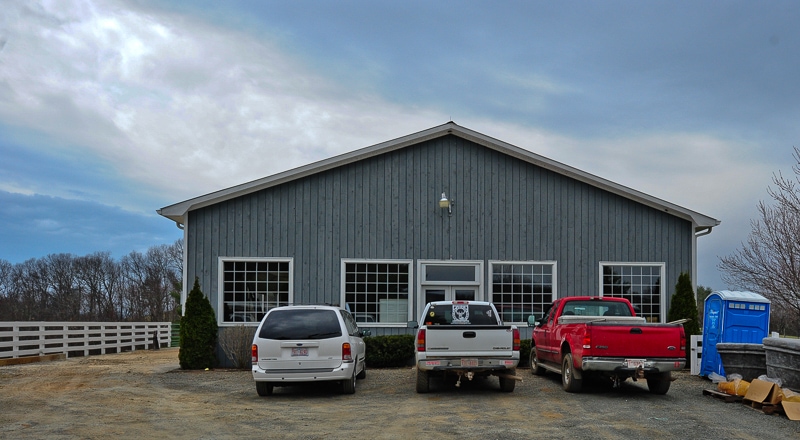
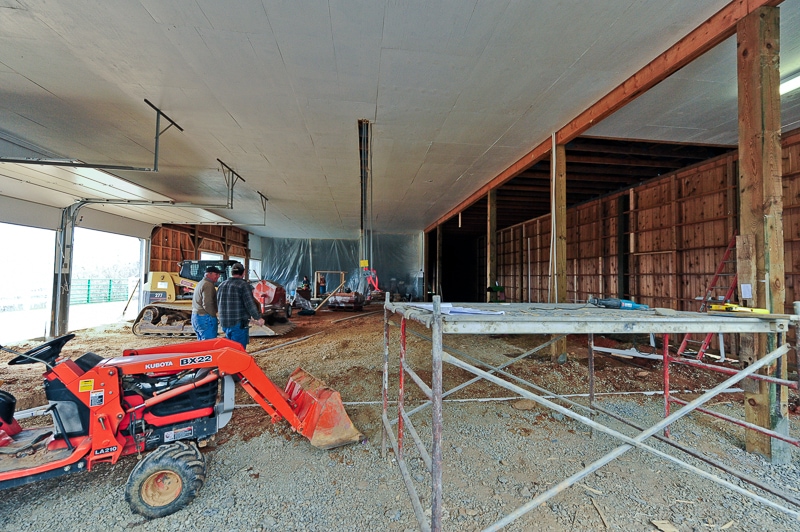
Jim Becher’s emailed comments after we finished:
“Your crew to the man was fantastic in every respect. Eric is a gentleman in every respect and what a talent and fine representative of Carolina Timberworks. Thanks for a great job and experience.”
Located on over 700 acres in the rolling mountains of Alleghany County in western North Carolina, Bittersweet Farms is home to over 300 head of black Angus and black Belted Galloway cattle.
New Jersey Party Barn
Don’t have an existing working cattle barn on your property to renovate? Build a new party barn either using a relocated antique post and beam barn or use new timbers and build a party barn like this one. Brandes Maselli Architects selected Carolina Timberworks to fabricate and erect the timber frame for a new Party Barn located on a golf course in Bedminster, NJ.
To keep the cost of building a party barn down, new rough-sawn Douglas Fir was chosen for the timber frame. It’s not easy to replicate the patina of time and weather-worn barn timber. At first glance, a piece of antique timber looks gray. A closer inspection will reveal subtle brown, black, and silver shades. We’ve seen new timber faux finishes in an attempt to duplicate the look of aged timber, but it often falls short of the mark (good from afar, but far from good). However, the finish that Michael Brandes’ painting subcontractor applied to these new timbers is, in our opinion, quite authentic.
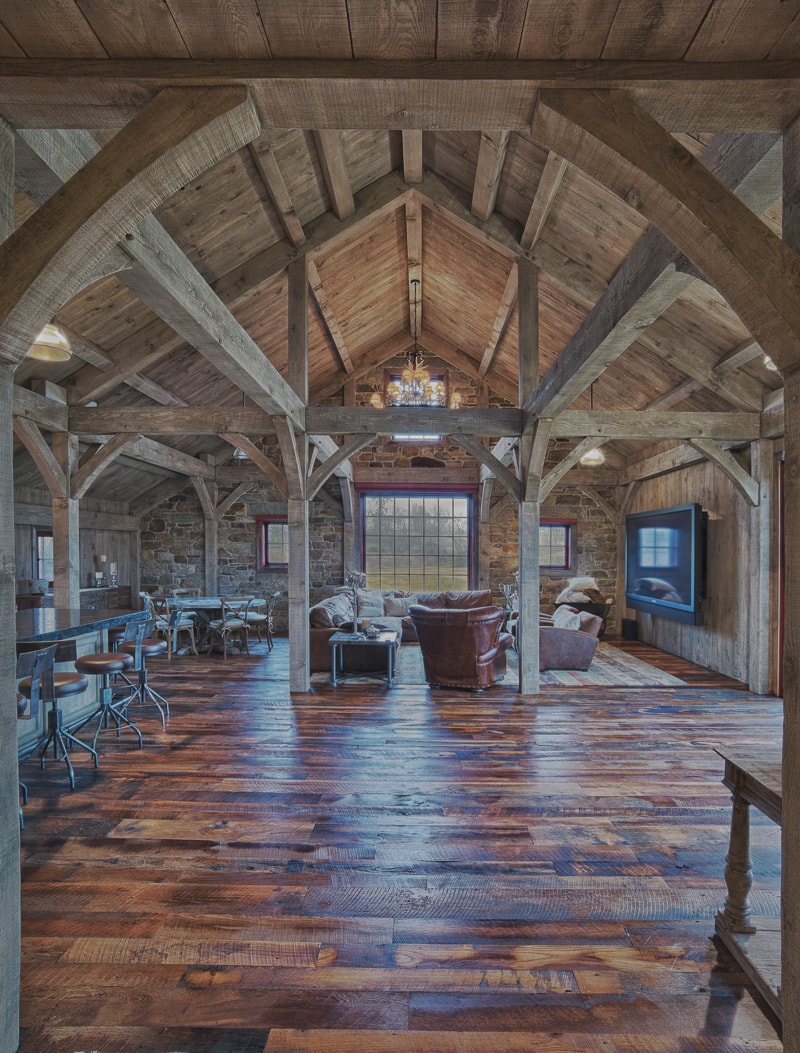
Three years later, it was decided that the party barn needed a silo. We built the timber framed domed silo roof from Douglas Fir reclaimed from the San Diego and Arizona Eastern Railway, better known as “The Impossible Railroad.” Built between 1907 – 1919, the construction of this 146-mile long railroad from San Diego to El Centro to the east overcame a series of catastrophes and misfortunes including, but not limited to, the Mexican Revolution, a prolonged legal battle, floods, World War I, labor shortages, tunnel collapses, and a pandemic thrown in for good measure.
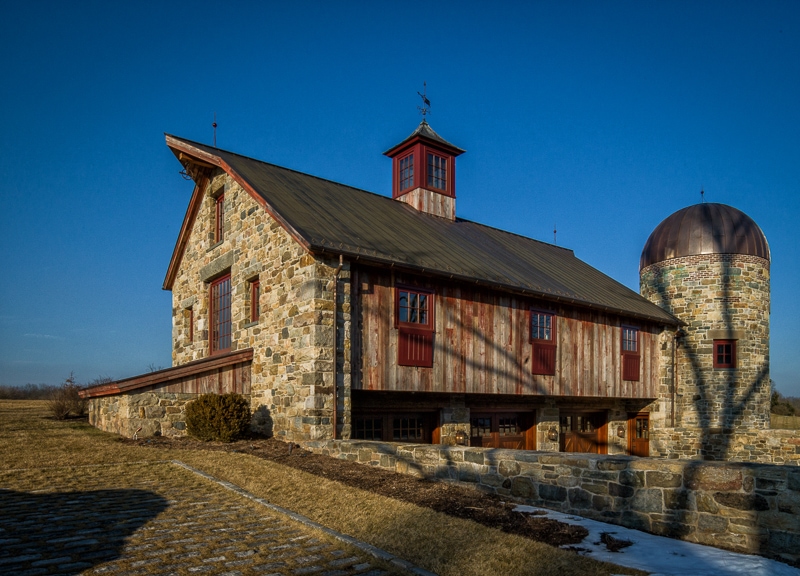
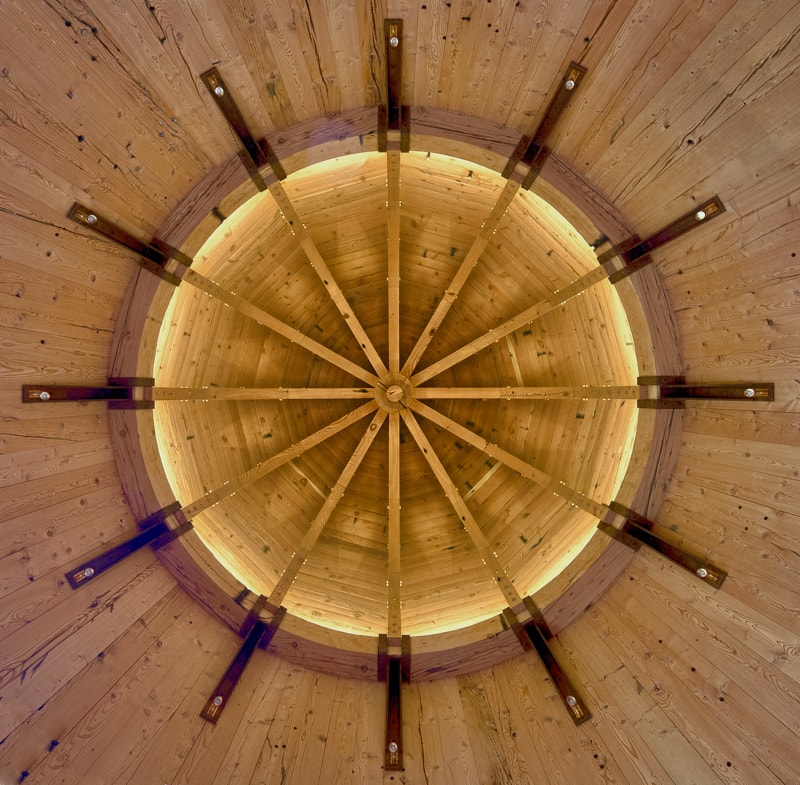
North Carolina Mountains Party Barn
Upon seeing the photographs of these party barns, a friend of mine exclaimed, “Everybody should have a party barn!”
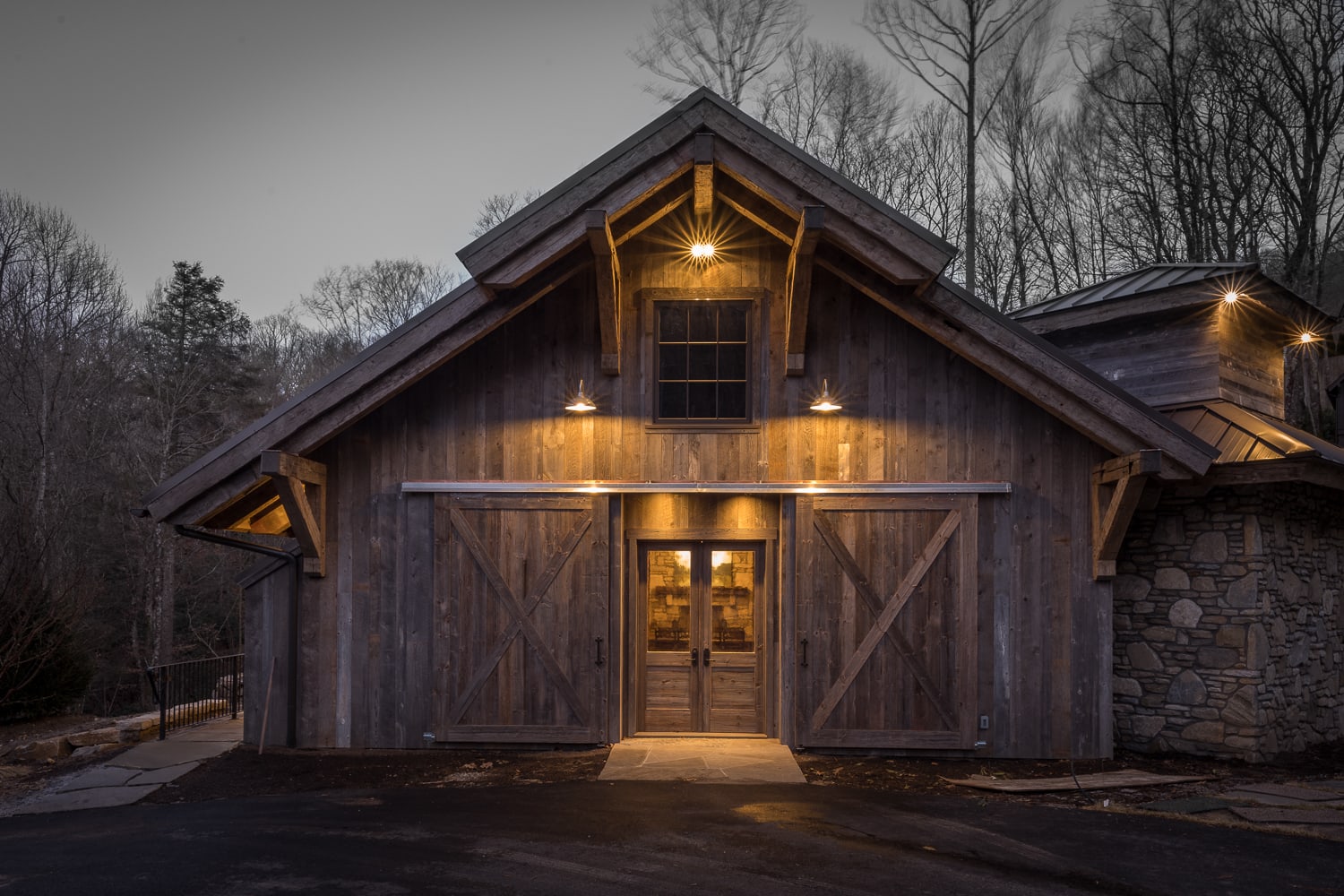
Want to learn more about the timber elements that make this barn unique? Check out our Timber Frame Glossary for insights into key framing terms.
How to Build Your Timber Frame Party Barn
There’s something wonderful about breathing new life into an old structure, especially when you transform it into a space that’s bustling with happy experiences and memorable gatherings. Are you curious about how to get started with a party barn project? Learn more about our building process and how we approach timber frame construction.
Read More: Timber Frame Barn Homes
Nature’s Carbon Fiber: Wood in a Renovo Badash 29er
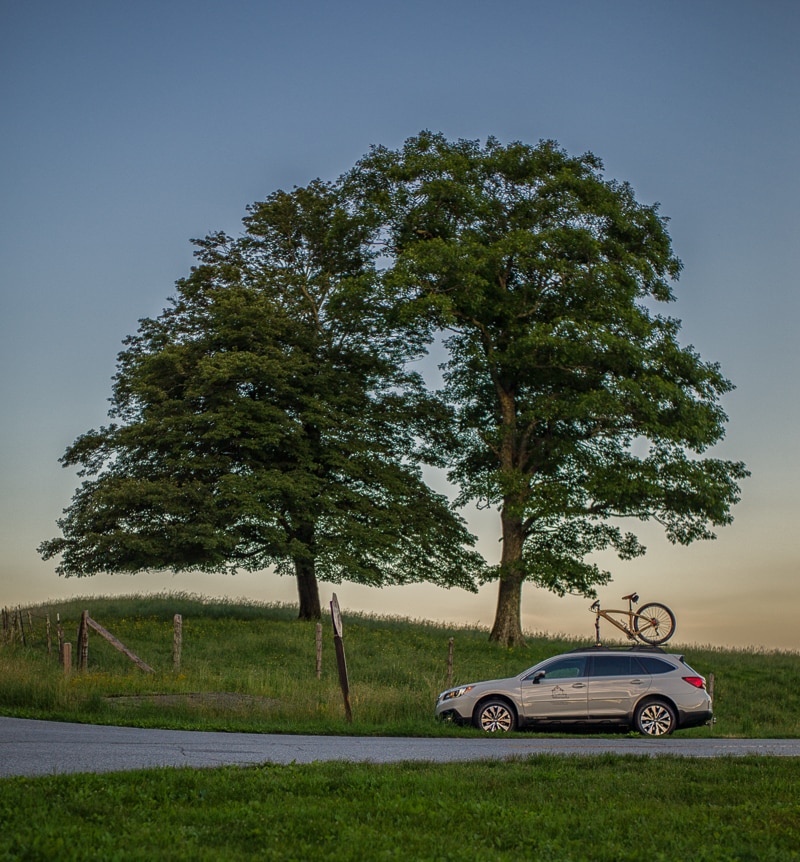
Two of the Prettiest Oak Trees on the Blue Ridge Parkway…and the Carolina Timberworks Renovo Badash 29er Carbon Fiber Wood Bike
Most people stop for a closer look when they see our wooden mountain bike, and have questions. “Is it really wood?” Yes. “Did you make it?” No. “How does it ride?” Amazing.
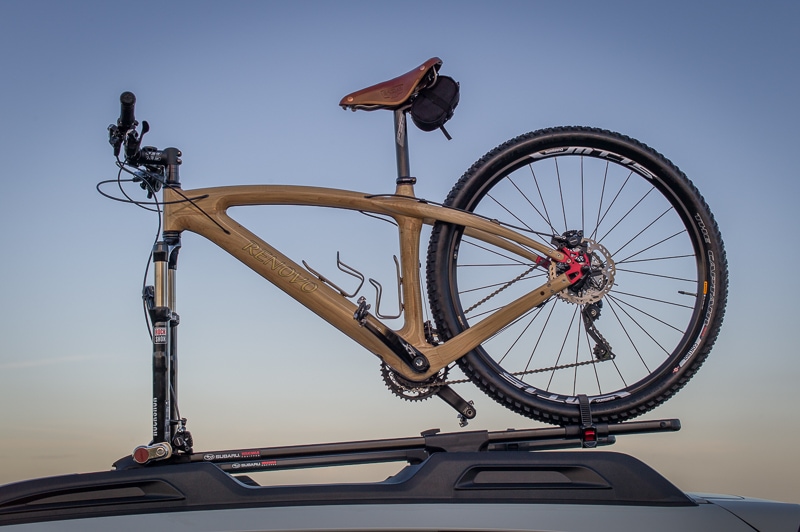
Meet the Renovo Badash 29er, hand made from Curly Hickory with Padauk accents by Renovo in Portland, Oregon.
Wood bikes, not unlike timber frames, are functional art. Both are hand made from Nature’s Carbon Fiber…wood. Why wood? Wood absorbs vibration better than metal or carbon fiber, and produces a smoother quieter ride. Renovo’s owner, Ken Wheeler, is an engineer who started out designing composite aircraft. He noticed that in many ways, wood’s properties are superior to composites and calls wood “nature’s carbon fiber”. Wood is strong, lightweight, sustainable…and gorgeous.
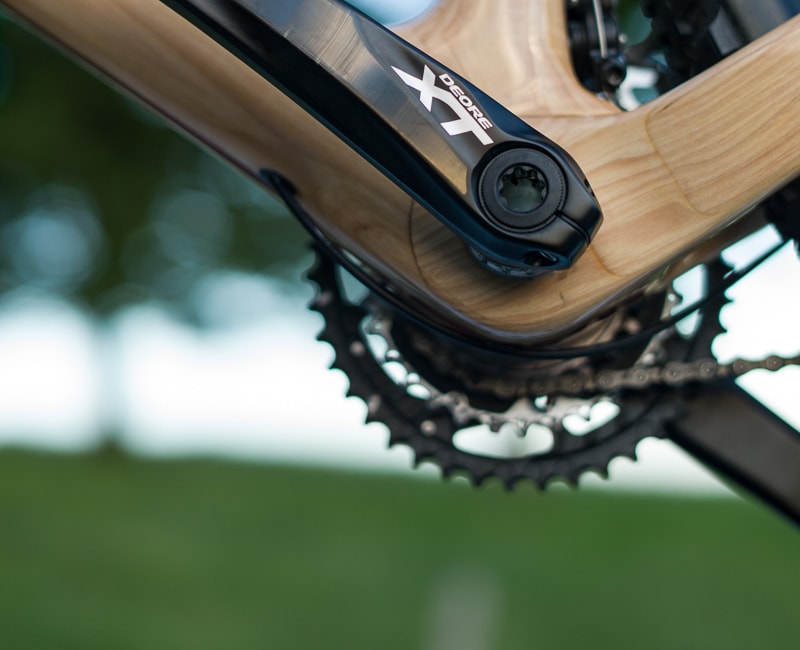
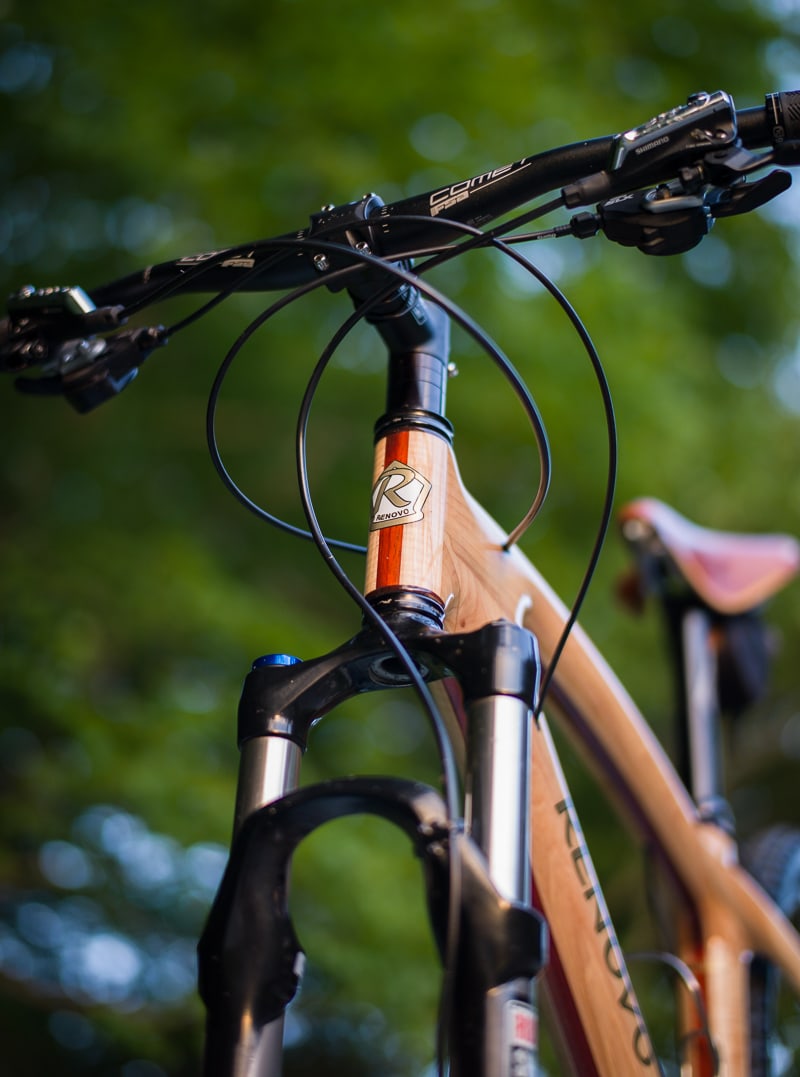
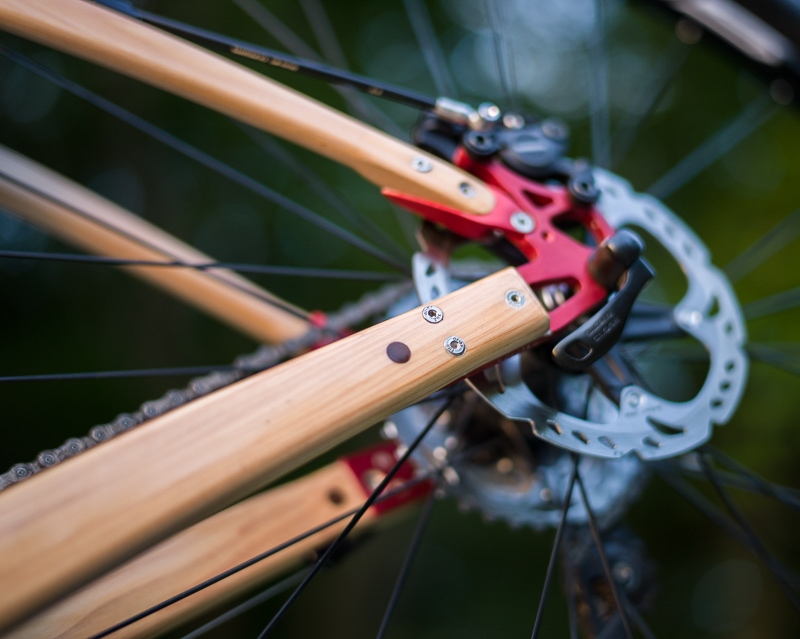
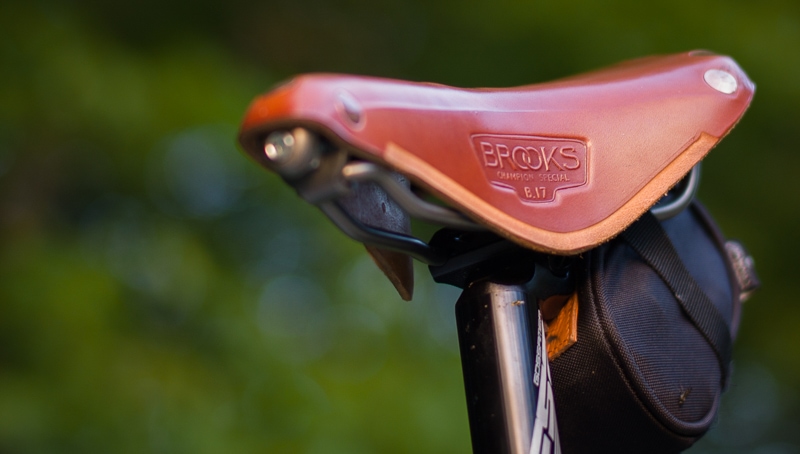
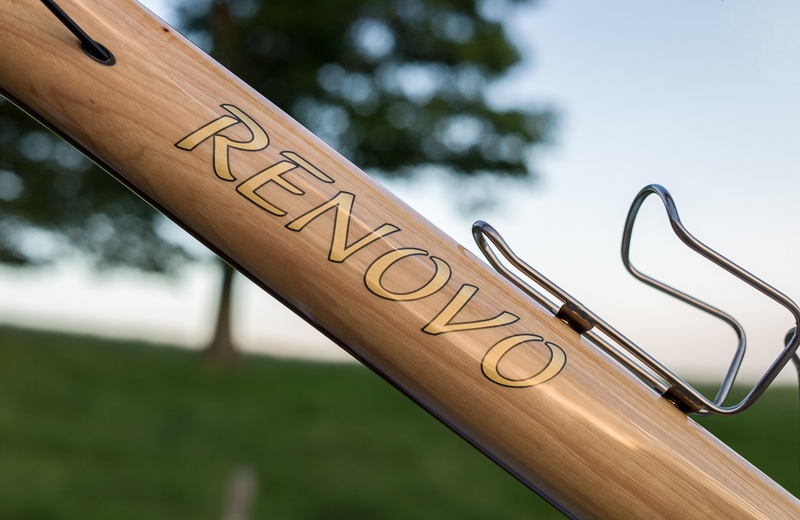
“The magnificence of the early 1900s WPA and Railroad Destination lodges captured my imagination years ago when I first visited the Ahwahnee Lodge in Yosemite. But I’ve always assumed the craftsmanship which created that art and beauty had long since disappeared. When Eric Morley of Carolina Timberworks called to order a bike, of course I had to take a look at their website. If you’re reading this, you know…their work is just stunning, giving nothing to the lodges I have always loved. So now Eric has one of my bikes and I have one of his screensavers. I need to raise prices.” Ken Wheeler, Renovo Hardwood Bikes.
2019 update: Sadly, Renovo is no longer in business. Check out https://connorcycles.com
Is Timber Framing Sustainable?
Wood is the world’s most environmentally-friendly building material.
Timber framing is one of the best ways to conserve our resources because post and beam homes are special places that people love, and because they are loved, they are maintained over the years, and because of that care, post and beam homes last for centuries rather than decades. Buildings that are loved get maintained, and well-maintained buildings last far longer.
Why is Timber Framing Sustainable?
- Wood is one of our only renewable resources. Think about this sometimes overlooked and obvious fact.
- Timber is a natural product. Is timber sustainable? Yes! It is recyclable, biodegradable, and renewable. It does not off-gas toxins because there are none.
Timber, unlike 2×4 and 2×6 lumber, upon the end of the useful life of the timber frame or post and beam home, will be carefully dismantled and reused. Used 2x4s may one day be reused, but today are going into landfills, rotting, and releasing their stored carbon into the atmosphere.
Wood is a carbon sink. If kept dry, wood lasts indefinitely. If you leave a tree in the forest to die a natural death, it will rot and release its stored carbon. If you cut down a tree at the end of its natural life, it has spent years storing carbon and producing oxygen. If you then fabricate it into a timber frame, and keep it dry for centuries, the post and beam home is acting as a long-term carbon storage unit.
Post and beam homes can, and often do, use less wood than stick-built homes. The figure we’ve heard is around 30% less. There are some caveats here, and it may seem counter-intuitive at first, but take a look at the photo (at left) from Stewart Elliot of Riverbend Timber framing.
Timber frame homes use big timbers which come from big trees. Here’s another counter-intuitive one. Big timbers come from big trees–sometimes old-growth trees. Big trees have spent many, many years storing carbon and producing oxygen. Today’s 2x4s are manufactured from young, small trees – trees that have not lived long enough to store much carbon or to have produced much oxygen.
What we’re doing to make 2x4s cheaply is to grow genetically-engineered super fast-growing trees, cutting them down in 10 years, and then replanting. By the way, when we replant these crop trees, we’re not doing it by hand. We’re burning diesel fuel. Is it a cheaper way to produce a 2×4? Undoubtedly. Is it greener wood? We’re not so sure.
Timber frames or post and beam homes are the best use of old trees. In our view, it is far greener to cut down a majestic old-growth Douglas Fir tree at the end of its life, and fabricate it into a functional and gorgeous timber frame that will be treasured and maintained for centuries, than to cut it down and saw it into 2x4s that will eventually go into a landfill and rot, or produce window sashes which will rot, or make paper. Better to revere these fantastic trees by turning them into an architectural solution to a structural problem that is so stunning and useful that generations of people will benefit from, and take care of the building.
Some post and beam homes are built without cutting down a single tree by using reclaimed wood and beams from old buildings and factories. Adaptive reuse is growing in popularity across the timber frame and construction industries.
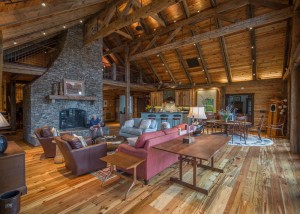
Nearby is a photograph of one of our timber homes that utilized reclaimed wood. We love putting old wood back to work, and the sustainable timber in this project is structural and is holding up the roof.
Timber framing is a darker shade of green. Having spent a week in a photovoltaic solar class, we’d note that no building material or technology is without consequences to the environment–not even solar panels. We contend that timber frame and post and beam homes, while not an environmentally perfect building solution, are demonstrably and quantifiably greener than most other conventional building methods.
Is there progress to be made? Sure! Yet, even so, timber framing, teamed with structural insulated panels and solar photovoltaic panels, is the most beautiful, green, and energy-efficient method of building we know of.
Speaking of progress, in 2022 we installed solar panels on our new building:
